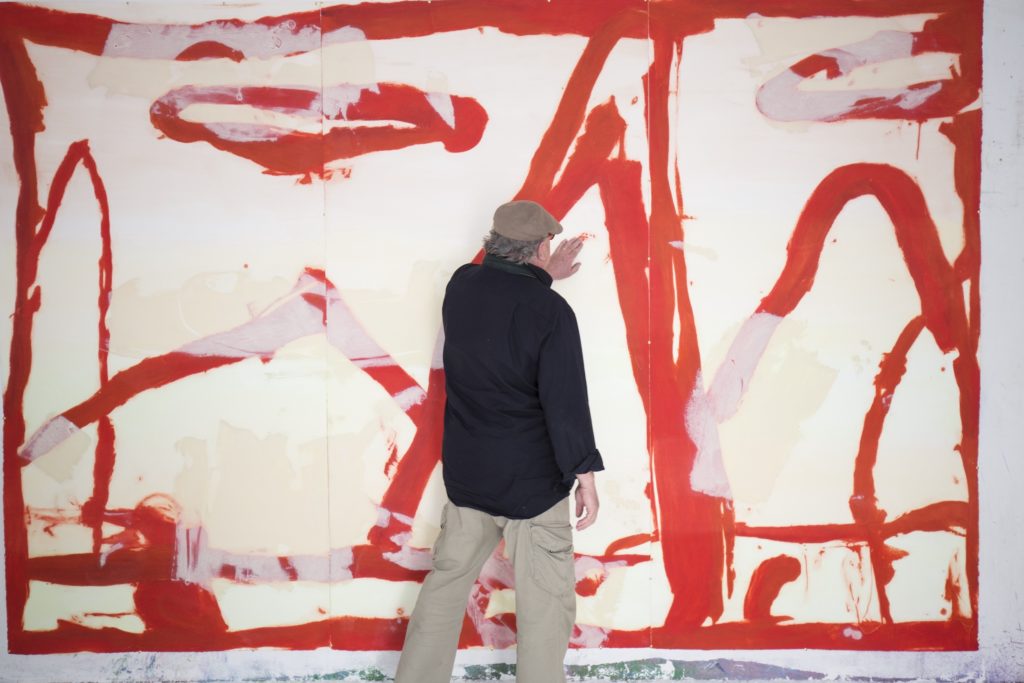
Artist Q&A with Peter Godwin
by Dr Claudia Milburn
Q. I’m interested in what gave you the impetus to show your work after many years being reluctant to do so?
A. I was being patient, waiting for a sense of stability.
Q. Having taught extensively in your career, can you tell me what has been the significance of teaching to you?
A. Great satisfaction in maintaining a particular artistic lineage, e.g. Ingres> Degas> Bromberg>Auerbach. I experienced a lineage in Australia while delaying the stabilisation of my own work.
Q. The project called ‘The Painters Journey’ took you to Hong Kong and Guilin with painter Euan Macleod. Can you tell me about this project and the impact of your experiences?
A. Having spent minimal time in China, I’m still reflecting on that experience in my work a decade on.
Q. Can you talk about the Chinese landscape subject matter of these works and, more broadly, the significance of landscape as subject?
A. The landscape being a different physical experience and trying to rework a cliché. Landscape is not a subject as such, it is an experience.
Q. How have different environments inspired your practice?
A. The word inspiration has always bemused me, I prefer ‘felt’.
Q. You have mentioned that your venture into printmaking was particularly inspired by seeing a series of large-scale prints by Howard Hodgkin. Can you talk about the impression these works had on you?
A. Howard’s work is by a painter through and through, never shallow even when minimal. His work breathes similarly to Turner’s watercolours, rare I feel for an English painter and the works demanding scale.
Q. How do the processes of printmaking and painting relate to each other in your work?
A. The carborundum process is very painterly as sugar lift is in intaglio etching.
Q. These prints have the restraint of single focused colour, or two colours accompanied by white – can you talk about this restraint of colour palette?
A. I wanted the drawing to be paramount not the subject or sense of depiction.
Q. Many of these prints are of vast immersive scale. What is the significance of working at this scale to you?
A. Because I could, the mountains were towers, again they were ’felt’.
Q. Who or what has been your greatest influence as an artist? Which artists have most inspired your practice, both in painting and in printmaking?
A. My major artistic influence as a student was a Scottish born painter, Ian Fairweather, I was not alone in responding to his work. Also the work of Australian painter, (English born), Tony Tuckson. It’s interesting that the two painters broke free of their formal culture and landscape when experiencing Australia’s informal cultures and landscape, read indigenous. – I might acknowledge painters I respect and admire but they have never inspired me, I would also mention poets in the same vein.
Q. What for you are the desired essential qualities of image-making?
A. Self-belief mixed with anxiety.
Q. What are the latest developments in your work?
A. My last painting and the unknown.
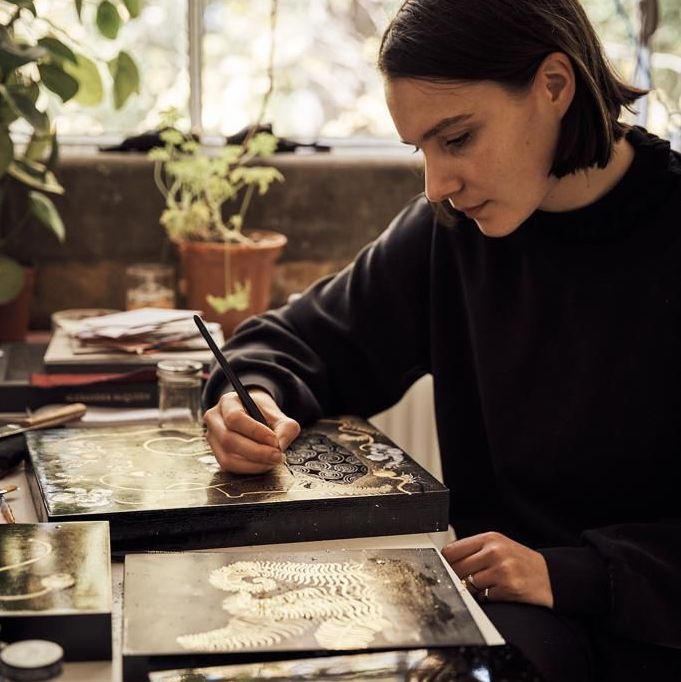
Small Worlds: On Beatrix Potter and Tuesday Riddell
by Anna Souter
In 1896, Beatrix Potter wrote in her diary: “We as outsiders express a pleasing, fresh irreverence for leading botanical authorities, it really does seem very impertinent, but the [facts] are there. It may just be that one sees them because one has an open mind, not in a groove.” Potter believed that working outside the academic tradition and scientific institutions afforded her greater independence of thought and a clearer understanding of flora and fauna; escaping the constraints experienced by the “authorities”, Potter was able to look with an “open mind” to the wonderful possibilities of the natural world.
Of course, working independently was Potter’s only option. When her uncle contrived to show some of her illustrations of fungi to botanists at Kew Gardens, her work was dismissed due to her age and gender; the resident scientists were sceptical that someone in Potters’ position could have come up with plausible theories based on experiments conducted without guidance and in an amateur setting. However, many of the ideas she expresses through her illustrations, such as the symbiotic relationships between many fungi and algal species, are now considered to be more advanced than the botanical knowledge widely held by the male gatekeepers of the science at the time.
Potter did manage to get a (now sadly lost) paper, “On the Germination of the Species of Agaricineae”, read at the Linnean Society soon after this rejection – albeit by a third party as women were not allowed to attend. However, since it seemed impossible that she would gain proper recognition or any degree of financial independence from her work as a naturalist, Potter turned to children’s books, combining narrative and illustration in publications that remain well-loved to this day.
Potter’s illustrative work is unique in how it combines the scientific accuracy of an experienced naturalist with the whimsical inventions of an artist who understands how to appeal to the child’s imagination. Her genius was to dress zoologically correct animals in human clothes, based on a lifetime of study at home and outdoors. For example, when Potter’s publisher complained that the mottled legs emerging from Jeremy Fisher’s red tailcoat and embroidered waistcoat were too yellow, Potter marched over to the offices of Frederick Warne & Co with her pet frog Punch in a jam jar to prove the accuracy of her drawings. She was determined that her books should be lessons in natural history as well as entertainment.
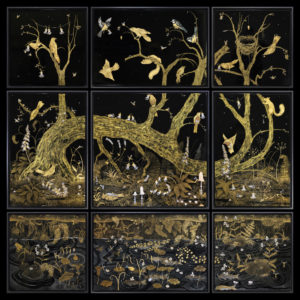 For artist Tuesday Riddell, Beatrix Potter’s small worlds represent a radical continuity between the magical and the real, where close observation of landscapes and ecosystems runs smoothly into a profound re-enchantment with the more-than-human. For Riddell, as for Potter, gaining an intimate knowledge of another being does not strip it of its personhood or its animacy, but rather enhances these qualities and offers a doorway into an imaginative empathy and sense of wonder.
For artist Tuesday Riddell, Beatrix Potter’s small worlds represent a radical continuity between the magical and the real, where close observation of landscapes and ecosystems runs smoothly into a profound re-enchantment with the more-than-human. For Riddell, as for Potter, gaining an intimate knowledge of another being does not strip it of its personhood or its animacy, but rather enhances these qualities and offers a doorway into an imaginative empathy and sense of wonder.
Much of Riddell’s work is closely inspired by the illustrations of animal worlds she encountered in the books of her childhood, with a particular emphasis on the work of Beatrix Potter. Riddell’s images explore the interconnected lives of fungi, insects, birds, and mammals, often in the context of the forest floor or the banks of a body of water. Many of her shimmering, multi-layered images are set in the mysterious hours of darkness and twilight, suggesting a realm of imagined animal encounters, where secret gatherings take place in the absence of human watchers. Like Potter, Riddell creates spaces and relationships which are both fantastical and natural.
Riddell works with japanning, a technique originally developed in the 17th century as an imitation of Asian lacquer work. She learned the process at City & Guilds Art School as part of the Painter-Stainers’ decorative surfaces fellowship, which provides students with specialist training in endangered crafts. For each work, Riddell starts by sanding and polishing a wooden board, before applying between 25 and 30 layers of European lacquer with a brush. The brush marks are removed by sanding and polishing the surface of the lacquer between every three layers.
After the lacquer has cured to a black, mirrored surface, the artist begins to mark out the central composition, which she usually sketches straight onto the board without extensive pre-planning. She marks out key silhouettes of plants, animals, and insects, before using lustre powders to develop the background. She then fills in the silhouettes using pigmented shading and adds detail using gold and silver leaf. Finally, the whole piece is sealed with a layer of shellac or varnish.
For Riddell, there is a parallel to be drawn between endangered crafts and endangered species, and her work attempts to draw attention to both. Her work is as much concerned with the natural world as it is with processes of making; in the midst of the ecological crisis, the delicate, intricate japanning technique reflects the fragility of our ecosystems and our complex relationship with the natural world.
The central work in Tuesday Riddell’s solo presentation at Messum’s London is directly inspired by a visit to Beatrix Potter’s farm, Hilltop, in the Lake District. On a walk through the surrounding countryside, Riddell came across a tree that had fallen beside a small stream, crossing it like a bridge. The tree had begun to sprout new branches growing upwards, resiliently reclaiming vertical growth despite falling to a horizontal position.
Riddell has populated her version of this bowed and twisted – but lively – tree with an ensemble cast of birds, mammals, insects, plants, and mushrooms. These protagonists interact with and respond to each other: blue tits carry off the bell-shaped flowers of a foxglove; a moth rests on the spongey cap of a mushroom; a cocooned caterpillar hangs above a bird’s nest like a baby’s mobile. Although Riddell’s animals are not anthropomorphised in the same way as Potter’s, she similarly allows miniature narratives to emerge within this microcosm, hinting at distinct relationships and personalities among her nonhuman characters.
Riddell’s process involves close observation of wildlife, often in the urban parks, gardens, and waysides surrounding her London home. After absorbing information and picking out small details, she returns to the studio and begins sketching, often drawing directly onto a meticulously prepared gleaming panel. The artist demonstrates an astonishing ability to capture the nuances of other species through working primarily from memory and the imagination.
There is a theatrical quality to Riddell’s work, which combines the naturalistic with the aestheticized in a way that is inspired by the stylised illustrations of children’s books. As in many fairy tales and Victorian stories for children, Riddell’s images contain a potent element of darkness. Her works often incorporate small scenes of conflict, death, or decay, belying initial impressions of perfect harmony. They speak to a widespread sense of unease over the uncanny indifference of nonhuman nature towards human ethics and morality. This can be found, too, in the writings of Beatrix Potter; to the discomfort of many contemporary parents, Potter’s smartly-dressed animals have not been stripped of their natural desire to eat each other, creating conflicts that are resolved only through escape rather than through compromise or moral revelations, as we might expect from children’s stories today.
The shimmering, multifaceted layers of Riddell’s japanned panels appear to shapeshift according to the angle and lighting. This constant metamorphosis infuses the works with a feeling of magic, conjuring another realm hidden a hair’s breadth from our own. Like Beatrix Potter, Riddell shows that there is an enchantment to be found in the comings and goings of everyday nature, from the scamperings of mice to the burrowings of earthworms, from the iridescent flash of a dragonfly’s wing to the quiet rotting of a fallen apple.
For both artists, close observation of the more-than-human is most effective when combined with the radical power of storytelling and the imagination. Riddell’s gleaming, mysterious works speak to the importance of looking at nature with what Beatrix Potter called an “open mind”: a receptiveness to the compelling blend of beauty and horror present in those small worlds that thrive alongside our own, if only we can take the time and look closely enough to notice them.
–
Bibliography:
Annemarie Bilclough (ed.), Beatrix Potter: Drawn to Nature (London, 2022)
Catherine Golden, “Beatrix Potter: Naturalist Artist” in Woman’s Art Journal, Vol. 11, No. 1 (Spring -Summer, 1990), 16-20
Rudolf Schmid, “Beatrix Potter [1866-1943] as a Mycologist: The Period before Peter Rabbit and Friends” in Taxon, Vol. 48, No. 2 (May, 1999), 438-443
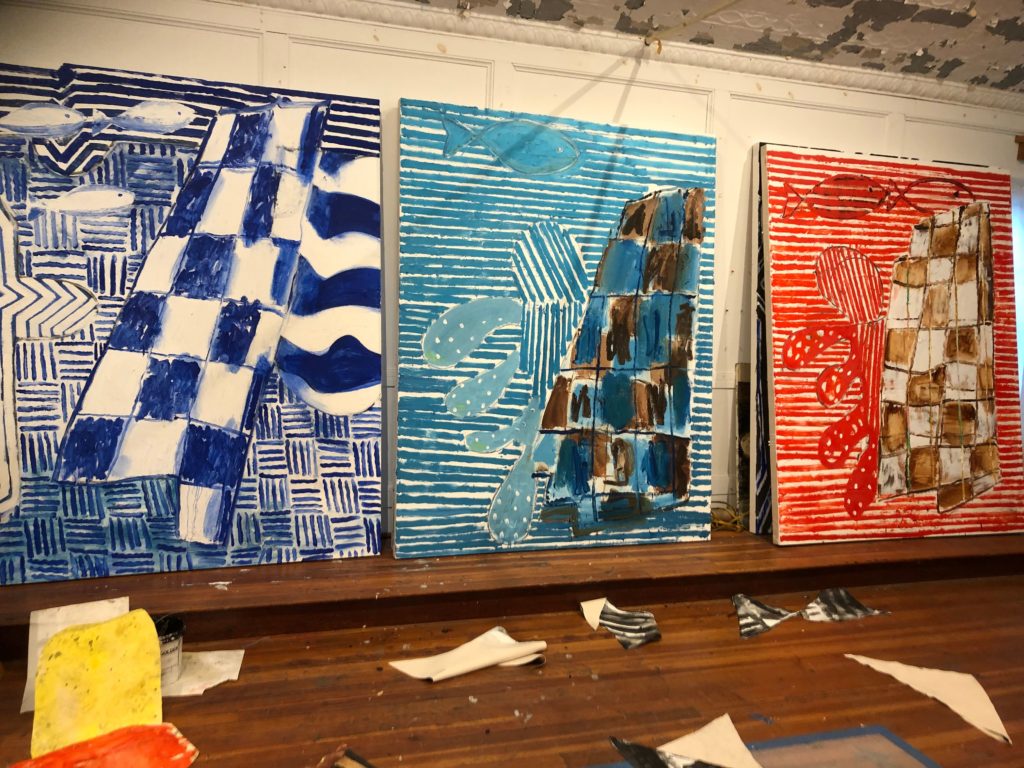
John Walker: The Intelligent Hand
By Suzette McAvoy, curator and writer
The landscape thinks itself in me, and I am its consciousness. —Paul Cézanne
The road to John Walker’s studio in Maine runs along the Pemaquid River, emptying into Muscongus Bay and the Atlantic Ocean. Pemaquid in native Abenaki means “situated far out,” and it is one of the oldest English settlements on the Maine coast. For centuries, eels have been fished here from late winter to early summer as they return to the river from the ocean to spawn. This annual ritual is the source of several of Walker’s new works. “Everything you see in the paintings, I’ve seen,” he says. “I’m trying to tell the truth as I see it.”[1]
Central to the compositions of Eel Running, Pemaquid, Pemaquid V, and Pemaquid VI are dramatic, swooping arcs of lines suggestive of the large mesh nets used in capturing the eels. Anchored by bold, patterned buoy shapes, the lines gather energy as they thrust upward, pushing out to the high horizon and the sea beyond. With their geometric crosshatched scaffolding, Resurrection I and Resurrection II intimate the fish ladders that aid the eels on their passage upstream. A favorite Tiepolo painting, The Descent from the Cross, 1772 (Museo del Prado), inspired the titles and compositions. Black Pond and Ripple are concerned with the patterns and movement of water as the tide comes in. Asked about the predominant use of cobalt blue, the artist simply replied, “Joy.”
“I forgot about impressionism, cubism, 20th-century art history, modernism, postmodernism – and saw only the story of his love affair, his liaison, with the visible,” wrote art critic John Berger on seeing the Cézanne exhibition at the Musée du Luxembourg in 2011.[2] My visit to Walker’s studio elicited a similar response. His latest paintings lined the walls, all large-scale, heavily textured canvases awash in lush, vibrant blue. Surrounded by water on the peninsula of land where he lives and works, Walker’s paintings are a testament to his sustained engagement with the visible world, not in the literal sense, but something more primal and poetic.
In this sense, he carries forward the influence of Winslow Homer, who painted his late, consequential seascapes at his home and studio in Prouts Neck, Maine, between 1890 and his death in 1910. Like Walker, Homer spent years studying the seasonal effects of time and tides on his circumscribed patch of coast. In works such as Weatherbeaten, 1894 (Portland Museum of Art), Homer distills nature to its most elemental, pitting the solid form of rocks against the ephemeral motion of the sea. His Prouts Neck seascapes, “balanced on the knife-edge between realism and abstraction,” struck new notes in American painting.[3]
John Marin followed Homer to Maine in the early decades of the 20th century and shared a similar commitment to place. Although he had been painting in various locales along the coast since 1914, Marin spent the last two decades of his life, from 1933 to 1953, at his home in Cape Split. The place, he said, “that lay closer to my heart than any place in the world.” Grounded in observation, Marin’s oil paintings from this period pulse with the energy of his vision in concert with the physicality of his medium. “A copied sea is not real—The artist having seen the sea—gives us his own seas which are real,” he stated.[4] Marin’s assertion of the artist’s reality mirrors Walker’s, “I am not trying to abstract the landscape; I’m trying to make, if anything, realism.”[5]
In the early 1980s, Walker became friendly with artist Richard Diebenkorn. They were both showing at Knoedler Gallery, and they’d go “gallery hopping” when the older artist was in town from California. Diebenkorn was working on his Ocean Park series, which he began in 1967 and continued for over twenty years. Walker had started to paint outdoors, and Diebenkorn was the first to encourage him to show his landscapes. The commonality between the artists is revealed in Walker’s account of his visit to Diebenkorn’s studio in Ocean Park. “I walked down his street and it was like walking through a Richard Diebenkorn painting. When I got to the door and rang the bell, I said to him, ‘You’re just like Courbet, you’re a realist.’ He thought that was wonderful.”[6]
Diebenkorn painted and repainted his canvases, scraping away, reworking areas he thought too precious, leaving evidence of changes until the whole was just right. Walker works and reworks his paintings similarly, although to an even greater physical effect. His surfaces are palimpsests of earlier iterations. Textures range from sheer veils of color to thick accretions of paint and collaged canvas elements. His love affair with his medium, “colored mud,” as he expressively calls it, is palpable. “Touch is very important,” he says, “You have to listen to it. The sound of the brush on the canvas, and a lot of that sound comes through the hand, and the eye sees it, and the heart feels it—at its best.”[7]
The subject of touch comes up often in conversations with Walker. He speaks of looking at a Cézanne, “that tap, tap, tap, of the brush, a multitude of times he touches a painting.”
Rembrandt’s The Jewish Bride, he says, “is the best painting in the world to me, the sublime moment and expression of tenderness, her hand touches his hand.” The communal language among the artists he admires—a widely diverse group including Cézanne, Rembrandt, Constable, Soutine, Goya, Mondrian, Malevich, and the Aboriginal painters he met while teaching in Australia, and others—“It’s not about appearance. It’s certainly about touch. It’s certainly about presentation. It’s certainly about a vision.”[8]
Haptic communication between hand and eye is keenly present in Walker’s drawings, as evidenced in the selection in the current exhibition. “I’ve always felt the most important part of me was my hands, that’s where the intelligence was.” He has drawn continuously since childhood. His classroom teacher’s praise for his drawing of Robin Hood and his Merry Men at age seven—“I had articulated their limbs”—determined him to be an artist. Often he draws obsessively, making hundreds of drawings over days. “Drawing allows you to be extremely personal with yourself; one of its strengths is that,” he shares.[9]
The drawings serve as “idea sheets” and help him solve problems in the paintings he is working on. “Rather than just sitting, looking at a painting, I have to try and draw it as truthfully as I see it.” His favored medium is ink on Japanese rice paper, applied with various soft and stiff brushes. The absorbency of the paper enables the ink to soak through in areas, adding a ghostly richness to the image. Viewing a stack of drawings in the studio, he remarks, “the sound of the paper, it charms me…It’s like I can hear myself breathing.”[10]
Among Walker’s new seascapes, the still-life painting Clock and Shell is an outlier and a compendium of his concerns. It takes inspiration from Cézanne’s The Black Marble Clock, 1869-70 (Private collection), with its florid sensuous seashell and heavy marble clock, its face without hands, arranged on a linen-draped table. In contrast to the solid form in the Cézanne, Walker treats the clock as an outline transparent against the blue ground. It suggests a line from Pablo Neruda’s poem, Ode to Broken Things, “…that clock whose sound was the voice of our lives, the secret thread of our weeks.” Notable is what Walker leaves unsaid, the open edges and spaces between things, allowing for air and light to get in, for anticipation of things yet to come.
Suzette McAvoy is the former chief curator and executive director of the Center for Maine Contemporary Art in Rockland, Maine, where she organized the exhibition John Walker: From Seal Point in 2017.
[1] Unless otherwise noted, all quotes by the artist are from a conversation with the author at his studio in Maine on February 21, 2023.
[2] John Berger, “Cézanne: paint it black,” The Guardian, December 12, 2011.
[3] Bruce Robertson, Reckoning with Winslow Homer: His Late Paintings and Their Influence, published by The Cleveland Museum of Art in cooperation with Indiana University Press, 1990, Chapter Two, p. 25.
[4] John Sacret Young, John Marin: The Edge of Abstraction, catalog essay, Meredith Ward Fine Art, New York, NY, 2006, p. 8.
[5] John Walker in conversation with Jennifer Samet, The Sheldon Art Museum, University of Nebraska, video interview, March 6, 2019.
[6] John Walker in conversation with Erika b Hess, I Like Your Work, podcast, October 1, 2021.
[7] Ibid.
[8] Ibid.
[9] Ibid.
[10] The Brooklyn Rail, 64th Weekend Journal, Studio visit with John Walker by Bill Jensen and Margrit Lewczuk, video by Margrit Lewczuk, published November 22, 2020.
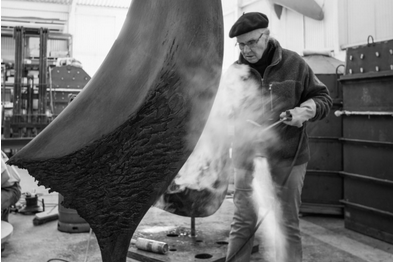
Bridget McCrum and Elisabeth Frink
Annette Ratuszniak
former curator, Elisabeth Frink Estate and Archive
Recently we came across a photograph by Eileen Agar taken in 1936 when she was in Brittany. The Bum-Thumb Rock image typifies Agar’s interest in the surrealist possibilities of natural objects, an absorption that she shared with Paul Nash during their entanglement.
The photograph reminded me of the stone carving by Bridget McCrum that Elisabeth Frink kept at Woolland, her Dorset home and workplace. McCrum’s sculpture was rediscovered among Frink’s plasters, studio materials and personal possessions in a warehouse where everything had languished for many years. The sculpture became informally known as Bridget McCrum’s ‘Bottom’ while its story was being unravelled.
The art and craft that Frink collected provides insights into her artistic interests and explorations. At first glance there seems little relationship between the stripped-down, modern classicism of McCrum’s stone carving and the semi-figurative expressionistic sculpture of Elisabeth Frink that was built in plaster and destined to be cast in bronze.
McCrum’s approach is reductive, removing mass from a block of stone using carving and sanding tools. She arrives at stylised shapes that play with light and weightlessness, as with her many birds which may be taking off, alighting or in flight.
Frink is often associated with sculpture that has jagged, emotive forms and rough surfaces. This is particularly evident in her early work, including her shape-shifting bird/beasts and birdmen that symbolise both aggression and vulnerability. But Frink was also absorbed in ideas of tranquillity, self-contained wholeness and human isolation, as she explained in 1954 when talking about her first Seated Man. In the 1960s she started to pare down her forms, arriving at broad, refined surfaces with shallow markings that play with the sweep of light. She added this approach to her repertoire as another way to reflect upon human actions and the consequences of global political upheavals.
McCrum, Frink, Agar: three women who each found ways to free themselves from the restraints of figurative precision. Their work is considered and suggests life through a shifting between shapes and images.
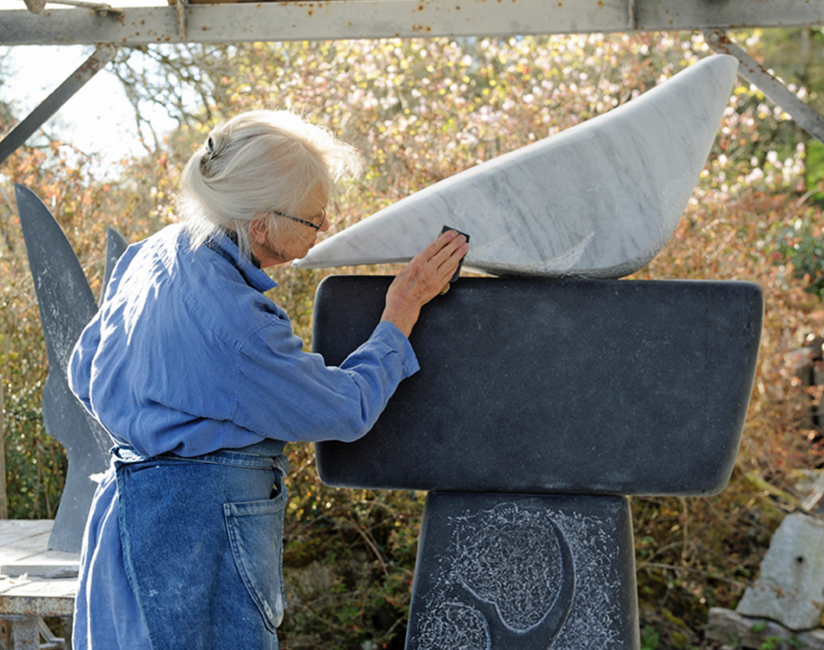
Bridget McCrum
by Will Gompertz, artistic director at Barbican
written in 2020
A little while back, maybe three or four years ago, I was invited to speak at a sculpture exhibition in the west of England. My informal lecture was to be one of many over the course of a weekend celebrating an outdoor show of contemporary British sculptors. I can’t recall exactly what I spoke about (nor, I should imagine, can anybody in the audience) but I do vividly remember another talk given shortly after mine. It was by one of the exhibiting artists and was far superior to anything I could, or did, muster.
The speaker was Bridget McCrum, a sculptor whose work I knew, but not intimately. Like most artists, she wasn’t exactly champing at the bit to stand up in front of a yurt full of strangers. She didn’t have any of the pro-speaker’s accoutrements. She was visibly nervous, there was a certain unfamiliarity with her slides (“now, why did I put that one in?”), and the talk was peppered with more “umms” and “ahhs” and “sorrys” than you’d hear at a Ryanair check-in. But you know what? It mattered not a jot. One hour later, we who had packed into the recently erected canvas tent until its seams creaked, were pleading for her to continue for another hour.
That didn’t happen. There were other talks planned. So, we mobbed her instead. Selfies, questions, congratulations, more selfies. We gushed, she blushed. For Bridget, it was the satisfactory culmination of a dreaded engagement. For me, it was a revelation.
I had heard a story about a woman who put her ambition to be an artist on hold until she’d raised her children. Who, in mid-life, made her first tentative steps in the art of carving stone, something she had wanted to do since the age of 5: an unusual aspiration for a little girl born blind in one eye. There was, she said, a fortuitous thread connecting her younger self – a war-time evacuee – to the artist she became thirty-five years later. That thread was Elisabeth Frink, the British modernist sculptor with whom McCrum enjoyed a life-long friendship. The two first met at school in Exmouth. Bridget was six, an exile from the Blitz in London; Lis was ten. They were horse mad, spending evenings drawing equine figures until it was time for bed. They stayed in touch over the following decades, with Frink encouraging her old friend to try her hand at carving. And when Bridget did so, Lis continued to support, not only with words but also with deeds.
Bridget’s husband, Bobby, was more confident of his wife’s talent than she was herself. While she was away exploring the ancient landscapes of Somalia, he packed up two of her earliest sculptures and entered them for the Royal Academy Summer Exhibition. Bridget would have been horrified. Who was she to be exhibiting at the venerated RA? Bobby knew better. And, so did Elisabeth Frink, who, on seeing Bottom (1984) installed at the RA asked her old friend to carve her a version of the nude lower torso for her own garden. Lis made only one recommendation: make it bigger!
Although Bridget has since moved away from human figuration in favour of birds, Bottom (a bronze edition of which is in the Messums show) fits into the overarching aesthetics of her practice. There is the simplified form that allows the eye to comprehend the piece as a single coherent whole, like a passage in a Bach Cello Suite. Less is more, no fuss. Balance is all. A sweeping line fades and then reappears as you move around the piece, invoking the optical effects the artist experienced among the dunes of the Arabian deserts. And with this comes a sense of rhythm and dynamism, of an object in motion, as light and shadow and perspective generate a kinetic energy. Such things are in the DNA of a Bridget McCrum sculpture or painting or drawing.
In the years since Bridget gave that talk in a tent, I have come to know her work a great deal better. As with most art of note, the more you look, the more you see; to the point where the invisible becomes visible. It seems to me that whatever medium she is working in, Bridget is as interested in the negative space as she is in her own interventions in the act of rendering a figure. Study her charcoal drawings of birds in flight and you will notice that the raw surface of the paper is far more than a plane on which to place a picture – it is playing an active part in the illusion: a collaborator in the creation of an image of a bird swooping through space.
The same applies to her sculptures. That they are elegant and graceful and sensual is plain to see, but what of the space around them? It is not a disinterested bystander. It has become part of the art, a contextual protagonist: an altered environment. The relationship between carved stone and landscape makes you ‘read’ each differently. This is why positioning is so important to Bridget: the surrounding physical space is part of her sculpture.
This, she explained in her talk. She showed us photographs. Some were of her working outside in the grounds of her house, which sits high above the River Dart in Devon, giving the artist a bird’s eye view of the birds circling below. Her slides reminded of the photos of Barbara Hepworth carving stone in her wonderfully terse A Pictorial Autobiography. Clearly, Hepworth has been an influence and inspiration to Bridget as a sculptor and also, perhaps, as a woman working in what has long been considered a man’s world. Hepworth’s muse was the rolling hills of Yorkshire, McCrum’s, the ancient objects of Mesopotamia: both artists finding their voice from bringing together the very old with the contemporary.
The Romanian sculptor Constantin Brancusi pursued a similar path, albeit from a different starting point. Bridget was trained as a painter at art school, Brancusi was taught wood carving. He left for Paris, she for a life as a Navy officer’s wife. They eventually arrived at the same conceptual place, with Brancusi leading the way, leaving a barely trodden path to follow. It was Brancusi who made the direct carving of materials – stone, wood, marble – fashionable in the eyes of the Parisian Avant-garde at the beginning of the Twentieth Century. It was Brancusi who showed what truths could be revealed when ancient stylised forms were combined with modern abstraction. And it was Brancusi who made the streamlined figure of a bird in space a subject for contemporary sculpture. But it was Bridget McCrum that set the bird free.
Brancusi’s birds tended to be static, Bridget’s are in motion: a Merlin on the tip if its wing, a raptor bearing down on its prey. Even when not in flight, her birds harbour a sense of imminent action: an awakening, or nesting, or – in the case of her knife birds – extravagant stretching. Some surfaces are rough, others are smooth. Some have been ‘scribbled’ upon, others are left untouched. Your senses become enlivened by the constantly changing nature of the material. Energy abounds in her sleek silhouettes.
Bridget ended her talk with images of the inspirational pieces and places she had seen and been on her many travels around the Mediterranean. Archaic knives and age-old axe-heads, giant rocks of salt and endless hills of sand; Egyptian hieroglyphics and Somalian artefacts. They are all there to be discovered in her work, which she continues to make day-in-day-out, even though she is now in her mid-eighties.
I was lucky enough to spend a few minutes with her once the crowds had cleared and the yurt was empty. She still looked a little worried. I was surprised, her lecture had gone so well. I asked what was troubling her. She said she had a lot of work to do for a big show in a colossal new space. Where, I enquired. In Wiltshire she said. Oh, what’s it called. Messums, she said.
She pulled it off, of course. And will do again. Welcome back Bridget.
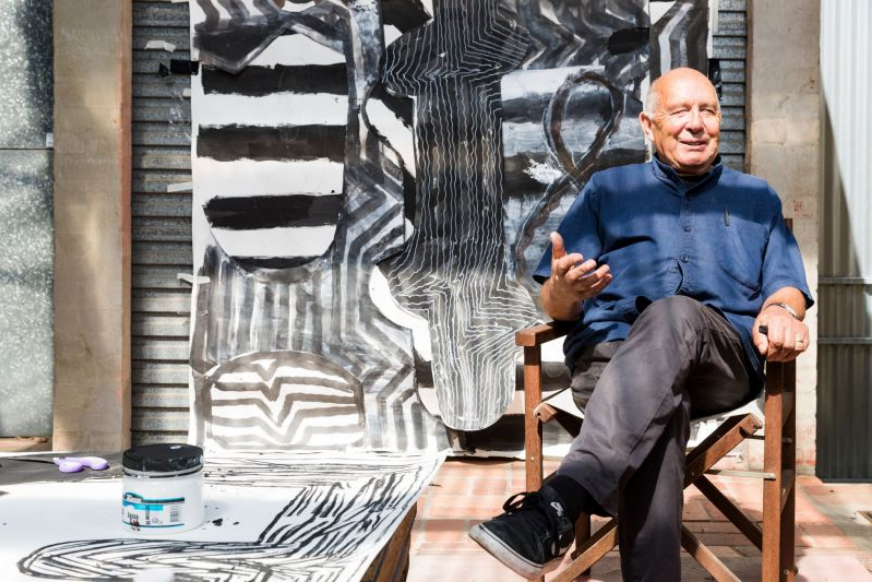
John Walker in Conversation with Fiona Gruber
courtesy of Melbourne University
Spending an hour with John Walker is a hugely stimulating experience. As a painter, he’s been part of an international art scene stretching back to the early 1960s; as an educator, his long career has encompassed three continents.
He’s full of anecdotes and opinions about art and artists, and I learn that the painter Mark Rothko once claimed he didn’t think colour important; that in Walker’s opinion Mondrian painted the best evocation of New York in his 1942-3 abstract grid painting Broadway Boogie Woogie; and that terms like abstraction, or abstract expressionism are, to him, a bit meaningless.
There’s a certain amount of arrogance connected with being an artist, he admits. “The idea that you can do it to the exclusion of everything and everyone else.”
But there’s also humility, because it’s only occasionally that you make something really special, he says.
“Over a lifetime of painting you remember ones that you touch somewhere and suddenly it comes back at you. It lights up. It’s a very rare thing.”
He also reveals how he stops painting when he gets bored, but how he’s quite pleased when works return to his studio unsold.
“I love paintings to come back from exhibitions; then I can paint on them again. My dealer will call me and say ‘you know that blue painting? I think I’ve sold it’ and I say ‘no you haven’t, it’s a red one now.’’
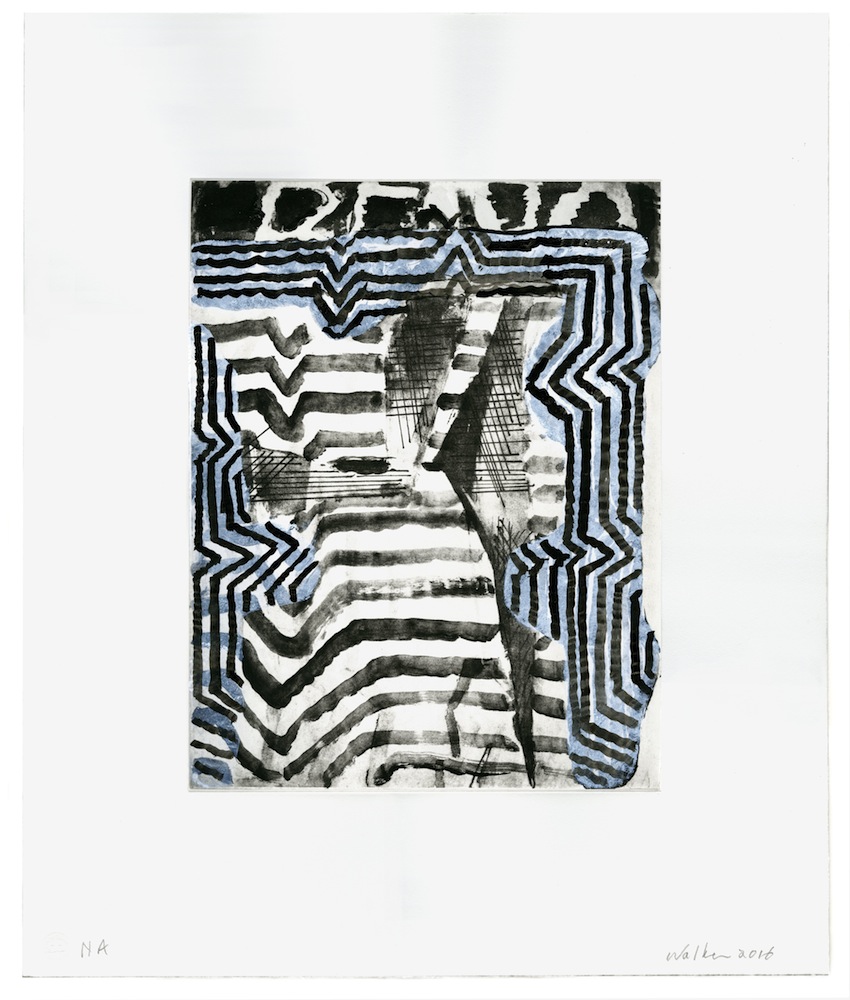
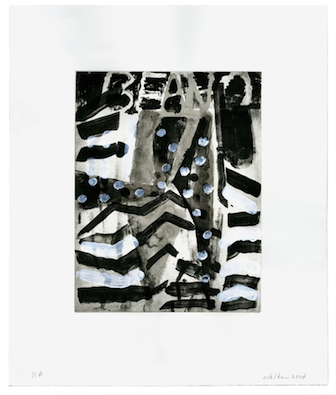
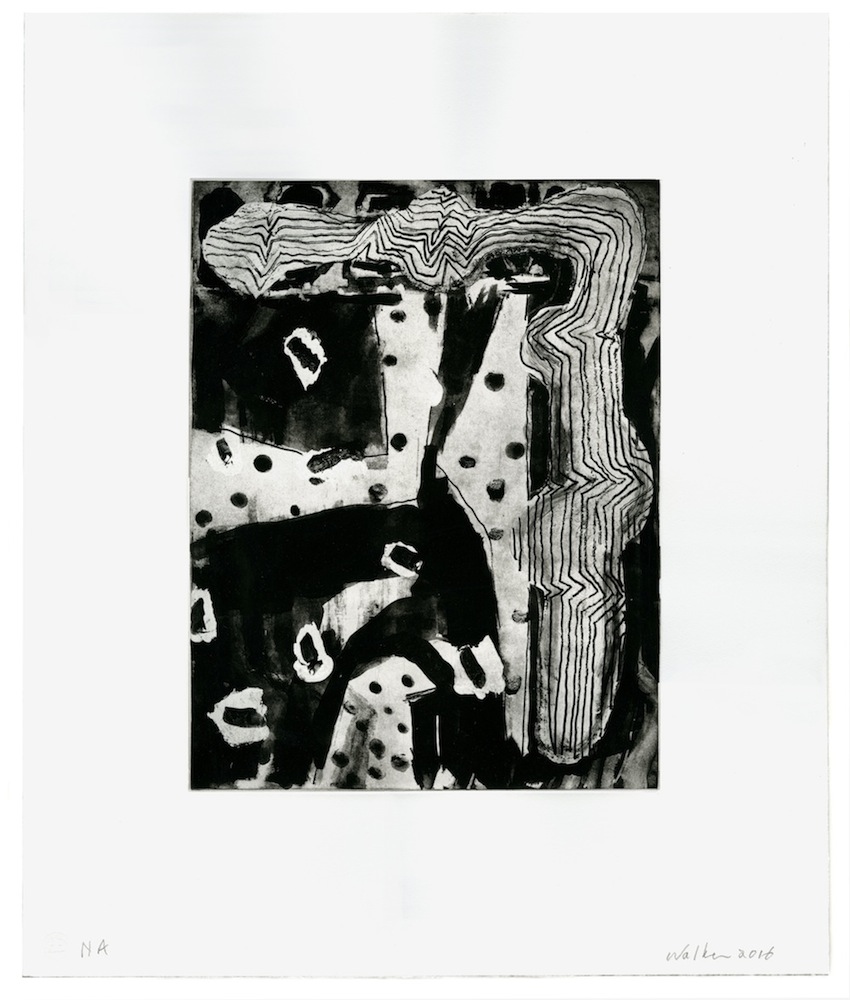
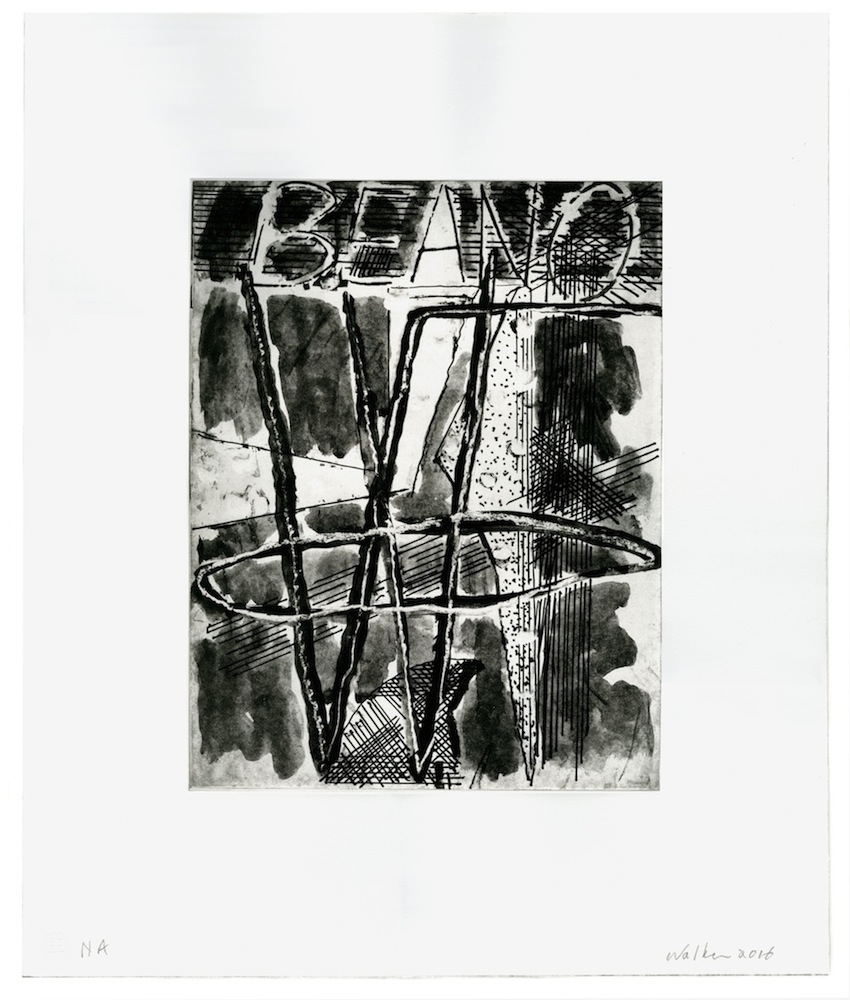
John Walker, Caitlin Lee #5, #7, #8 and #9 (2016). Image at columbia.edu. Image courtesy of the artist.
Walker, whom one critic described as “one of the standout abstract painters of the past 50 years,” is 78 and lives in the northerly state of Maine in the USA. Between 1993 and 2013 he was Professor of Art at Boston University School of Visual Arts and Head of its graduate program in painting and sculpture.
Born in England, his connection with Melbourne dates back to the late 70s and he was Dean of the VCA School of Art between 1982 and 1986.
His legacy lives on, not just in the students and faculty members he influenced but in the studio and gallery complex, Gertrude Contemporary, which he kick-started in 1985 and which is still going strong.
So it seems fitting that I meet up with him in the Norma Redpath studio, in inner-city Carlton, where he’s enjoying a month’s stay as artist-in-residence and showing his wife, artist Kayla Mohammadi, around Melbourne.
Redpath, a sculptor, left her workplace and residence to the University of Melbourne; in September 2017, Gertrude Contemporary and VCA, which now manages it, initiated a joint residency for international artists here.
Walker’s sitting in a leafy courtyard at a table dappled with sunlight. Behind him, from the wall outside one of the studios, he’s hung large sheets of paper and, from the look of things, has been busy, with paint and charcoal, on a series of black and white works.
Just as at his American home by the sea in South Bristol, he says he keeps up a daily routine of heading for the studio, reading the papers and then getting down to work.
“If you’re not there it ain’t gonna happen,” he states matter-of-factly, in a voice that still bears strong traces of the English Midlands and the city of Birmingham where he grew up in the 1940s and 50s.
At both the VCA and at Boston he kept a studio in the art school and the door was always open to students. It was part of a larger philosophy of engagement and seemed only fair he says.
“If I could walk into their studios any time of day or night, I thought they should have that privilege with me.”
One of the lessons he hoped they’d learn, he explains, is that an artist paints a lot of dud work and that failure is a vital part of the journey.
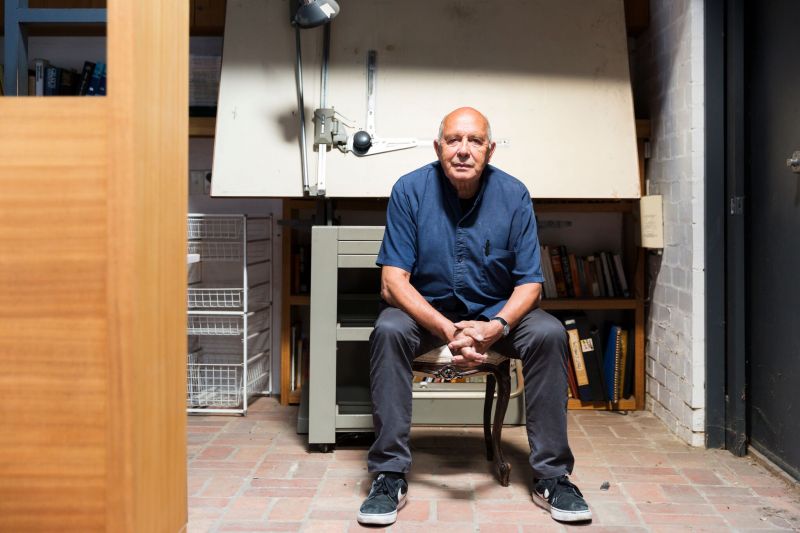 John Walker at the Norma Redpath Studio. Image by Drew Echberg.
John Walker at the Norma Redpath Studio. Image by Drew Echberg.
“At the VCA it was important that students should see someone who’s a so-called professional and how they go about making their art and the sheer amount of art they make … there should be the expectation of a lot of failed art which is good for them, because if they try and make a finished work every time they’re going to be a very bad artist.”
There seems to be a general consensus in the art world that Walker is a very good artist.
In 1985 he was a finalist for the Turner Prize; more recently, at the Yale Centre for British Art he was included in its 2010 exhibition “The Independent Eye: Contemporary British Art from the Collection of Samuel and Gabrielle Lurie” in a select group of post-WWII painting luminaries including Patrick Caulfield, Howard Hodgkin, John Hoyland, R. B. Kitaj and Ian Stephenson.
But success came early for Walker and he’d had his first solo show at London’s Hayward Gallery by the time he was 29, in 1968. As he puts it drily, he was “exhibiting with the big boys and girls.”
By the 1980s he was one of Britain’s most successful mid-career artists, with solo shows across Europe and the US including at the Hamburg Kunstverein in 1973 and the Museum of Modern Art in New York in 1974.
Sandwiched between those exhibitions, he’d also represented Britain at the Venice Biennale in 1972.
His painting career wasn’t the primary reason the VCA was keen to recruit Walker however; he’d also taught at some of the top schools in London and New York and been a visiting Professor at Yale University’s new Graduate School of Art and Architecture at New Haven.
It was in 1977 that his association with Australia began, with the Powell Street Gallery. Its dynamic co-director David Rosenthal, who was also a medic, had seen his work in New York and arranged for some to be shown at the South Yarra space.
Walker had also got to know the art historian Patrick McCaughey when they were both Harkness fellows in New York in the early 1970s. McCaughey went on to become the first professor of Fine Arts at Monash University in 1972. They kept in touch and in 1979 McCaughey offered him a Monash residency.
It was there that he had met his future wife, academic and art critic Memory Holloway. An artist’s residency at Prahran College of Advanced Education was arranged for the following year and the scene was set for a more permanent move to Australia. He says he left the UK gladly, although he knew he was waving goodbye to the British art world: “Basically it was the end of my career in England. The English, if you don’t let them love you they don’t like you anymore.”
Walker’s appointment to the post of Dean was a breath of fresh air says VCA’s current Head of Art, Jan Murray. “He was generous and encouraging,” she says, and “had a quiet authority that came from his international achievements…he had nothing to prove. He shifted the culture and once done it couldn’t be reversed.”
Walker says that his aim was to raise the bar higher.

John Walker, Walker Form with Yellow Shield (1986-87). Reproduced courtesy of the artist.
“I taught at Yale and the Royal College and they were like the elite institutions, and I was told that the VCA was an elite institution so I didn’t think there’d be any difference and in many ways there wasn’t, but I did feel that the expectations for students and to a degree the faculty wasn’t as professional as it was, say, at Yale.”
Norbert Loeffler, Lecturer in Critical and Theoretical Studies and one of the VCA’s longest-serving staff members, is less circumspect; he says that by the time Walker came to Melbourne, the city had several art schools and the number of students and professional artists had also grown considerably. The VCA was not doing well, he says, and Walker brought a much-needed dynamism and educational rigour to the college, which at that stage offered scant teaching of theory or history.
“In the late 70s and early 80s [the VCA] had started to drift and there was no compelling energy,” says Loeffler. “He was the ideal person; he came, saw it and said ‘we’re running specific classes, regular tutorials and a proper art theory and history program … we went from one class per week to 11 in one year.”
Walker says that although some faculty members were initially critical of his appointment – “people who didn’t want an Englishman running the school” – his approach combined appointing young teaching staff for energy (many young sessional teachers were brought in including Jan Murray, Howard Arkley, Bill Henson and Phil Hunter) and older ones for wisdom, and the “work hard party hard” approach won opponents over.
“[They] eventually came to the party because they could see the students were having a great time and they were learning so much,” he says.
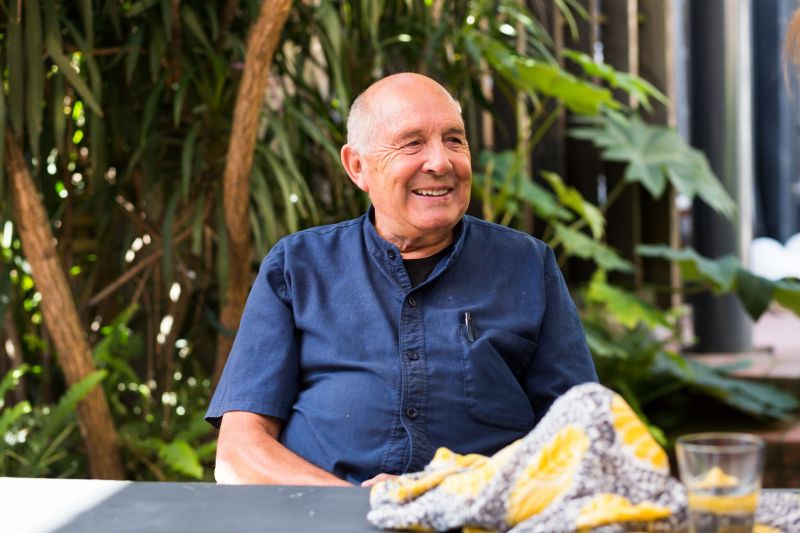 John Walker at the Norma Redpath Studio. Image by Drew Echberg.
John Walker at the Norma Redpath Studio. Image by Drew Echberg.
He also wanted to break the idea that the best art was being made elsewhere.
“When I started here, people used to look at me incredulously when I said ‘you don’t have to go anywhere’.”
One of Walker’s lasting legacies was setting up Gertrude Contemporary in 1985. Then known as 200 Gertrude Street, the combined studio and gallery complex in Fitzroy was a first for Australia.
The former textiles factory had been offered to the Victorian Council for the Arts (as it was then called) and Walker brokered a deal for a year’s rent with the building’s owner, Philip Cormie, which included one of his paintings and $10,000 of his own money.
Of his beneficence, he says: “If nice things happen to you, you should give back, and people had been terribly generous to me.”
The complex was a response to the isolation experienced by artists post-college, says Walker.
“I was concerned that my graduate students were not being supported once they left school,” he says. The deal, explains Walker, was that it was open to all art school graduates, not just those from VCA; that each artist had to pay for power and that they couldn’t stay for more than two years.
The first director of the exhibition space was Louise Neri, currently a director of the international Gagosian Galleries.
After getting the ball rolling, he then left it for others to run, including his then-wife, Holloway, who was co-chair.
Murray, who had one of the first residencies, said the Gertrude Street complex reflected Walker’s knowledge of similar ventures overseas, including the collective PS 1 in New York.
Its exhibitions soon became a magnet, she says, in an era before the explosion of artist run initiatives in the 1990s.
“He supplied a destination and it was ecumenical. We needed a network and a community and it was pretty amazing in terms of the vision John lent and the generational focus it gave. A lot came out of it.”
Earlier this year, Gertrude Contemporary left its inner-city premises and has relocated to Preston. It maintains its two-year studio residencies and has stuck with 16 of them, as in the original building. Mark Feary, its current director, says it’s still unique in an Australian context.

John Walker at the Norma Redpath Studio. Image by Drew Echberg.
“Having a community of artists forms deep connections between them … it’s always done very well as it fights against hermetic practices,” he says. The new space might lack the grungy charm of the former, he adds “but it’s taken its history with it and for the first time we’ve been able to architecturally develop the spaces.”
Walker is keen on things developing, and against organisations becoming too bureaucratic. He’s glad that Gertrude Contemporary has moved on.
His time in Australia sparked new ideas; the paintings and drawings he did here include his Oceania series and his Prahran Etchings as he soaked up Australian and regional cultural influences. And he’s continued to exhibit here too, with a show at Tim Olsen Gallery, Sydney, in 2012.
He muses on the difference between the art he did as a young man and the art he’s making now. Is he a better painter? I ask.
“Different. One of the things I’d tell my students is ‘you can’t paint an old man’s painting. You can paint a 21-year-old’s painting and I can’t paint a 21-year-old’s painting, only an old man’s one. But a masterpiece is equally available to both of us.’”
And although he cautioned his students that many artists commit themselves to “a very lonely life, mostly in a room on your own” he says that if you dedicate yourself wholeheartedly there’s nothing better.
“Look what it gets you if you really do it; it gives you a wonderful life. I feel blessed.”
By Fiona Gruber
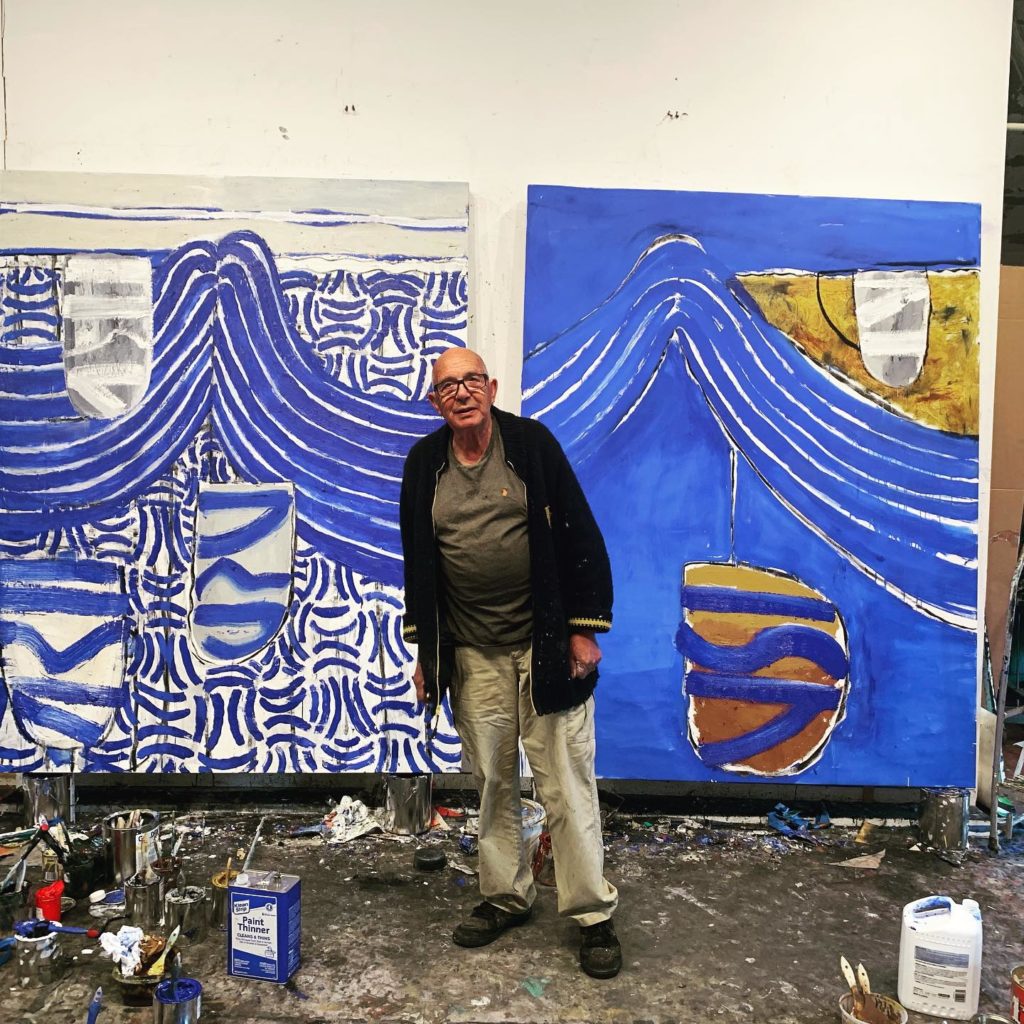
An essay and interview by Colin Smith, Associate Editor of Turps Banana Painting Magazine.
Revisited and edited March 2019
A friend who works with Sculpture and Installation said to me recently “The problem with Painting is that it has too much history”. My instantaneous reply was “That’s one of the very things that I most like about it.” I’m fairly confident John Walker’s answer would have been similar.
My first encounter with him as a student at the Royal College of Art in the late 1970s was not necessarily an easy one. His work was extraordinarily prominent and highly thought of at that time and there was barely a student who was not making pastiches of his work. I was one of the few who was not but when he saw what I was trying to do he was characteristically perceptive, helpful and sympathetic. Later he was instrumental in helping me get a Harkness Fellowship to Yale, and we still meet up from time to time.
It has always struck me as profoundly unjust that over the decades since he moved away from the UK, sometime around the mid-1980s, his work once so prominent should have vanished from sight along with him, and that a large number of younger artists were completely unaware of his practice. His work now seems as relevant as ever and about ten years ago, with the backing of Turps Banana Painting Magazine, I flew off to Boston to interview him and to try and set that situation right.
John’s reputation in the USA, where he has been living for some time now, is securely established and unquestioned. His involvement with the dilemmas of illusion and surface have always been paramount. Film critics often reference the emotional agency of depicted space in movies, seldom referenced in that way by commentators on the plastic arts. Space, or the illusion of it, has always been prominent in John’s practice and to my mind is much more relevant than the introduction of ‘namable’ subject matter or even text. The Door is perhaps a more fitting metaphor for John’s paintings than The Window, and the subject matter or text could be seen only as a possible key, nothing more, nothing less. Complexity or contradiction has never really been problematic for the poetic imagination. As the art world seems to be devolving into part of the entertainment industry, these works vastly repay any effort demanded to understand them, their context and background. This new and exciting exhibition of John’s work is long overdue.
Here follows an updated version of my interview with John, which despite some years having passed still offers many insights.
CS: One clear trait of you practice is a determination to apply the paint in varied and unexpected ways.
JW: I’ve always been interested in what you may call talking with the brush - that’s something inherent in great painting. The way the artist kind of talks himself through a space or a distinctive form. It was one of the things that worried me about a lot of my friends’ paintings, Minimalists if you like, this throwing-out of the language of the brush. It was there in the paintings I admired, that distinctive touch which you see in a Chardin for example and which makes you gasp when you see the beauty of it.
CS: Could it be said that your attention was moving away from just the act of painting, towards referencing things outside of that?
JW: Well, that’s true to an extent. I’d come to feel with the ‘collage paintings’ that they were solid enough to feel – if you hit one for example, you’d break your hand. But I suppose what I’d reverted to was that it was no longer just about force because I’d always believed the same of say a Vermeer painting that if it fell on you it could kill you because it’s so finitely structured. There’s a dialogue going on all the time and even though I thought the collage paintings were going well what was missing in the paintings was ‘going back to air’ – how do you paint air? I was beginning to feel I’m not doing the things I care about. I was looking at Rembrandt’s portraits for example – how do you paint the space around a form?
CS: Would it be fair to say that in the past you were interested in the ‘whole painting’ as an image, whereas now you are becoming more interested in an image ‘within’ the work?
JW: To an extent it was: “how can I find a form which I can place with air around it?”
CS: I seem to remember reading years ago that you’d quoted Picasso saying that he wanted his paintings to stop just this side of abstraction and that you wanted your paintings to stop just this side of figuration.
JW: One of the most inspiring things I ever read was by Malevich, who, when asked what his ambition was, said to imbue a square with feeling. Somehow that square had to act figuratively – not abstractly, even though it was an abstract form. It’s the same with Rothko – you’re not just seeing a rectangle, those forms somehow act figuratively on you. Someone who doesn’t do it so well is Barnett Newman. If he hadn’t called those paintings Stations Of The Cross they would just be black and white paintings.
CS: Some of the dialogues, which have unfolded in your work over the years have an affinity with Guston – the reintroduction of ‘nameable’ imagery for example. He seemed to have had a road to Damascus conversion, whereas your developments seem to have evolved more slowly.
JW: It’s very much a narrative thing – there’s a lot of narration in Guston. Even though I met him several times it’s quite hard to talk about him. The language or the ‘touch’ of paint is always the most important, and some times the subject matter is just a kind of filler.
CS: Would you agree that the forms in your work are usually defined by the edges of shapes rather than by the brush marks modeling them? The marks seem more to animate the shapes rather than model them?
JW: I spend a lot of time trying to work out where things meet – where form meets space. I spend a lot of time trying to activate that area. That’s where drawing is. I love looking at Albers – the precision of where the colours meet creates drawing.
CS: Let’s talk about the way you have represented space in your paintings. Very often the forms or planes lie parallel to the picture surface.
JW: Everyone seems to have his or her own definition of what the picture plane is. I suppose I wanted to place the forms in front of the picture plane. I am thinking of one particular Cezanne self-portrait, where he established the picture plane very early on in an area just behind the ear, then, later on, everything else has a discussion with that part. There is a kind of building in and out of the picture plane. The painting in the Phillips Collection in Washington seems to exist in the space between you and the surface. The painting is about four feet away but Cezanne is only about two and a half feet away.
CS: I suppose what I mean is, in say the Alba paintings, the forms and the areas around them are upright as opposed to your paintings, which have a recessive sloping surface. From my own experience I know it is easier to get the marks to lie down and fuse with the forms when they are parallel.
JW: Well, that’s the problem with landscape painting – you find that things move away from you pretty quickly. The thing is you are always making a painting. There’s a physical difference between what is a ‘view’ and a ‘painting’. Most of those paintings were actually started outside in the landscape, then when I had something there I brought them in and had a dialogue with the work, then took them out again and to see if they ‘fitted’, to see if they were then actually part of the landscape. They don’t have to look like it.
CS: Are they based on a specific area?
JW: Very much so. I’ve been going up to this area, where I have a studio in Maine, over many years, and it really happened about the time I had a breakdown and I didn’t really know where I was going. I found this cove where all the shit came in out of the ocean. When the tide went there was all this mud and it fitted into a group of paintings where mud was the central theme – homage pictures to my father who fought in the First World War. It took a long time but I suppose what I wanted was for people to be able to say I knew more about this spot than anyone else in the world. Cezanne knew more about Mont Sainte-Victoire than anyone else, and I‘ve got my little piece of mud! It changes all the time, every time the tide rolls in or out.
CS: It coincided with a difficult period in your life?
JW: Yes, there was a period of about eighteen months when I just could not work. The landscape refreshed me and helped me to come back.
CS: Tell me about the introduction of text into the paintings.
JW: It came at first from a drawing my daughter had made of a birthday card which included the text For You, and then I made a big painting, which I still think well of, with those words on it. Then it grew a little bit and there’s a whole series of paintings somewhere of birthday cards.
CS: That relates to you not wanting to exclude anything from paintings.
JW: Yes, I just don’t want those rules.
CS: I’ve found a quote from way back that says, more or less, you don’t like maximum impact paintings, but prefer ones that reveal themselves more slowly. What was the context for that?
JW: That’s a really early statement, from when I was a very young man. There was a time when, for a while, I found my art being exhibited alongside Warhol and Lichtenstein – all that wham-bam stuff. I felt my work was really not about the same thing at all, which in some sense forced me into a kind of retreat.
CS: What about Drawing and printmaking – you’ve done a lot of both. How do they fit in with the painting?
JW: Usually when I draw its to check the painting out. I don’t want to just rely on my eye and an immediate response - I want to try to visualise more, to internalise. To see how accurate the painting is. Did I really achieve the placing of forms I intended? I see the drawing as a confirmation, mostly after the painting. I found myself going out with watercolours into the landscape. I don’t need a camera. I want to feel I can paint anything. To me that’s one of the definitions of what a good artist is. Everything is available.
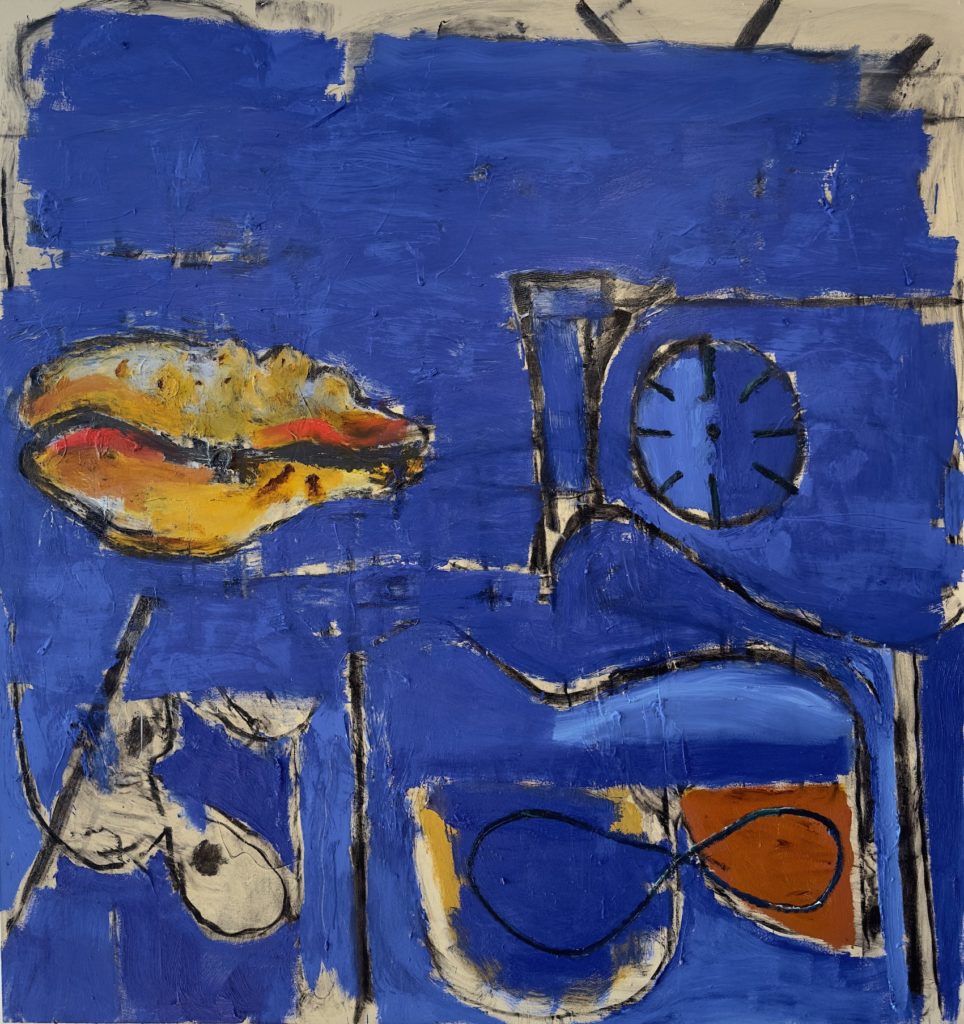
John Walker – Perception in Paint
by Dr Claudia Milburn, director of programming
written in February 2023.
John Walker’s dynamic ‘Blue Series’, a sequence of electric, large-scale paintings, all created in 2022, are testament to an artist who, now in his ninth decade, is working with a spirit and confidence accrued through a lifetime invested in exploratory endeavour. Walker had long held the ambition to create a body of blue paintings and, finally, the eight or nine buckets of blue paint which had been sitting in his studio for a decade, have found their way to the surface of the canvas. Typical of the artist, these works are therefore the result of considerable rumination. They are also finite, with the paint gone, Walker will move on.
Pictorial and pattern motifs echo throughout Walker’s oeuvre and this Blue Series is no exception. Sinuous lines, geometric patterns, repeating shapes, families of flattened forms – each unique but with shared characteristics – run through, creating a body of work brimming with vitality that invigorates the eye and livens the imagination. They are, to my mind, the summation of an artist who has interrogated the canvas over years of questioning, driven by the belief that “The painting is only any good when it’s presence is greater than I am.”[1]
In Pemaquid V, Pemaquid VII and Eel Running Pemaquid swathes of undulating waves traverse the canvas from opposite sides, colliding and merging centrally to create a dynamic meeting point while other shapes, rhythms and patterns dance across the surface. The paintings are dominated by the juxtaposition of two principal colours – a cobalt blue hue and a bright white. While other colours feature, notably shades of sienna, ochre and accents of jade in some of the works, it is the striking combination of blue and white which characterises the series. This colour coalescence, together with the fresh luminosity in the surface quality of the paint, brings to mind ancient Qinghua porcelain with its cobalt oxide pigment and translucent glaze. In Ripple II the blue and white oblique stripes zig-zag across the canvas, while in Resurrection I and II, a patchwork of horizontal and vertical lines criss-cross over areas of blocked colour with a textural quality reminiscent of basket-weave. In each case, the dominant patterns dynamically divide the picture plane. Walker’s mark-making is free, vigorous and direct; the paintings are immersive, enigmatic and atmospheric. It seems impossible not to respond to the all-consuming power and impact of the work.
A sense of place and the essential spirit of that place – the genius loci – are fundamental factors in Walker’s oeuvre. His life and career have taken him across continents to many different locations which have regularly provided core subjects for his work. In recent decades it has been his home territory in and around Seal Point in Maine, USA, that has provided the stimulus, this marine landscape inspiring countless canvases. It was, however, many years before he could use this location as subject matter, its scenic beauty had initially seemed too intense and overwhelming. This place had thus been absorbed and assimilated in his mind, time and time again, before it became a possibility to put brush to canvas. Located at the tip of the peninsula, Seal Point provides a unique panoramic landscape view of this part of the Atlantic coastline offering the ideas and impetus for Walker with the elemental drama of land, sea and sky. The ‘Pemaquid’ works relate to the picturesque peninsula in Maine, one of the region’s seven geographic ‘fingers’ close to the artist’s home. ‘Pemaquid’ is an Abenaki Indian term meaning ‘situated far out’ and representative of this coastal point, lying at the ocean’s edge. Tidal mud flats quilted with patterns of waves generated from the rhythms of the sea, currents of water rushing over the mud, rocky strata delineating the foreshore, reflections in the residual pools as light shimmers over – these are just some of the elements that characterise this inspiring location. It is a place in a constant state of flux forever animated by nature’s atmospheric conditions – shifting weather, time of day and the seasons. Walker is in tune with its sounds, shapes and sensations, its textures, colours and movement. These are the ingredients of his paintings, and it is his internalisation of these components, viewed at different times in different conditions, that coalesce on the canvas surface as a series of expressive shapes and forms. Moments and memories built over years permeate the works. All that enters the picture plane, every shape and gesture, has been absorbed by the artist over time, and his vision translated onto the surface of the work. These are not paintings with the intention to abstract, but moreover, to represent the veracity of the scene as witnessed and understood. They are emotive responses to his visual senses and his aim is to realise his impressions, to reflect a semblance true to his perception. In this way he is searching for the essence – a true Modernist in search for the fundamentals and authentic in his resolve. He believes in the power of painting to explore this quest and to investigate what it is ultimately possible for the medium to achieve. While Walker aims to know and understand this specific landscape around Seal Point like no other, the aspiration is always for the painting to take command, to tell him something he did not know before, to take him somewhere he has never been, and thus indicate a power of presence that has the ability to communicate truth, a higher state of reality.
The crescendo of sound created through the impact of Walker’s work has reverberated for generations. A prolific painter, he has continually confronted the issues that have plagued many artists in the second half of the 20th century and into the 21st and has faced up to the challenges posed by abstraction. In so doing, Walker has contributed to a significant narrative on Abstract Art and created a dialogue that has allowed for others to take heed and respond to the language of his work and its ability to communicate with such expressive potency. Walker represented Britain at the Venice Biennale of 1972 and has since taught across continents – in art schools in England including the Royal College of Art, at Yale University, during the 1980s as Dean of Victoria College of Art in Melbourne, Australia and, in more recent decades (from 1993 to 2015) at Boston University, Massachusetts, thus his influence on generations of artists has been far-reaching.
Walker’s first recognition of the potency of abstract art was in 1959 at the Tate Gallery’s exhibition The New American Painting where he encountered a work by Jackson Pollock entitled Number 12 that had a profound effect. Abstract Expressionism bore witness to a freedom of expression and a vitality of approach that was spontaneous and direct. For Walker, it was a visceral response – physical, honest and real. Urgent brushstrokes or paint liberally poured onto the canvas, colour interactions across the surface, a sense of active space, tensions in pictorial depth, the push and pull of forms, all evidencing pure unhindered expression. These works strongly resonated with Walker and fuelled a lifetime of exploration into the potential of painting as a medium to offer an impassioned language of authenticity. He comments, “When you paint something it has got to be perfectly honest and perfectly truthful. And that’s the only way. And that’s what New York has taught me.”[2]
Walker’s impact and his importance, stems partly from his constant innovation, he has been ceaseless in his quest, never settling, always charging forward, each time with renewed vigour and conviction, motivated by the mission of the work. As writer and critic Dore Ashton described in the introduction to Walker’s exhibition at the Hayward Gallery in 1985, he “works with the exuberance of a tinkerer or with the solemnity of an old master.”[3] He has long been preoccupied by shape, questioning its impact and significance. Through his work, he has persistently embraced the possibilities of form and considered how it is possible to truly imbue such form with meaning. As he expressed in 1972, “But if I was going to make non-objective art, the shapes I was going to use would have to have dignity, if you like. They would have to have a presence, always, which made them a sort of phenomenon. They conveyed feelings. They could not just be a red shade next to a black shade.”[4] In this, Malevich offered a touchstone to Walker, “One of the most inspiring things I ever read was by Malevich who, when asked what his ambition was, said to imbue a square with feeling. Somehow that square had to act figuratively – not abstractly, even though it was an abstract form.”[5] This, he realised, was the same mission undertaken by Rembrandt, to convey human emotion through the parameters of a pictorial image, and it was the recognition of this parallel that enabled the door to open into the potentiality of abstraction.
For shape to have substance and the composition of elements to have true merit, Walker has embraced a journey which has barely left a page unturned in the history of art. References to the European masters Rembrandt, Vermeer, Velazquez, Goya, Manet, Matisse and Picasso, among others have infiltrated the work. Walker comments “I am a painter, and I respond”[6] acknowledging the importance of this dialogue with the art of the past to provide the core building blocks to channel his direction in the present.
In his ‘Labyrinth’ series of the late 1970s and early 1980s Walker pays homage to Velazquez’s Las Meninas (1656) evidently relating to the multi-layered depths, interrogation of pictorial space and compositional drama in the iconic painting. A similar level of inspiration can be traced to Vermeer. Walker has referenced Vermeer’s View of Delft (c.1659-61) as an image that endures with him, no doubt influenced by the clarity of detail and gleaming richness of paint, comparable to the compelling diffused light and luminosity of intimate portraits within his interior studies. Walker has long been deeply affected by the intense pictorial language of Goya who he has described as his enduring hero, omnipresent in his mind and who has reduced him to tears on seeing his work in the Prado.Goya’s virtuosity of composition and the emotional, psychological drama of his paintings evidently resonate on a level that has penetrated Walker’s psyche and impacted his own approach.
Walker’s interrogation of the picture plane owes debt to the visual and structural analysis of Cubism and the possibilities opened by Picasso and Braque for their spatial invention and interpretation of form. Equally, Walker finds a close affinity with Matisse in a shared visual dialogue. The compression of depth and flattening of form, moving to the use of linear rhythms, colour interactions, evocative distortion of shape and composition as depicted by Matisse clearly struck a chord with Walker in his search to realise his own vision of the subject experienced. Walker, like Matisse, tenaciously pursues an idea in a process of interrogation and reconfiguration until achieving something close to the semblance of his perception, probing the very essence of painting. Matisse describes, “For me nature is always present. As in love, all depends on what the artist unconsciously projects on everything he sees. It is the quality of that projection, rather than the presence of a living person, that gives the artist’s vision of life.”[7] This same sentiment can be seen observed in Walker’s uncompromising determination to achieve his aim.
Integral to Walker’s practice, and his ability to gain proximity to the essence of his subject, is the process of drawing. For him, drawing is the essential lifeblood, the connection between heart, hand and mind. He draws daily to enable him to look, to think and to feel. Drawing enables him to examine and to understand, to deconstruct and reconfigure in order to get beneath the surface and reveal the essence. Walker’s engagement with drawing is revealing of what, for him, drives the creation of the work. His drawings are never preparatory, in fact, quite the opposite. He frequently draws from his paintings in a process of assimilation and questioning, a way to assess whether his paintings have achieved that which he is striving to convey. From drawing to painting back to drawing, he works assiduously until the image that he arrives at has this necessary vitality, as he describes, “I’m interested in what the painting has become not its intention. If the painting is going well it creates its own representation, its own reality so then I’m totally convinced it is reality.”[8] For Walker, one work leads into the next and then the next in a pursuit of perpetual discovery. It brings to mind the first line from T. S. Eliot’s poem ‘East Coker’ from the Four Quarters, “In my beginning is my end.”[9] The great gift of Walker’s work is in its presence, a result of his steadfast resolve and his belief in the transcendental power of painting.
© Dr Claudia Milburn, February 2023
[1] John Walker, Interview with Bowdoin College, 2017
[2] John Walker, “John Walker on his painting,” Studio International, June 1972, 244
[3] Dore Ashton, “Introduction”, John Walker, Hayward Gallery catalogue, 1985, 5
[4] John Walker, “John Walker on his painting,” Studio International, June 1972, 245
[5] John Walker, Interview with Colin Smith, associate editor of Turps Banana in Paintings, Prints and Works on Paper 2008-2018, Messums Wiltshire
[6] John Walker, “John Walker on his painting,” Studio International, June 1972, 244
[7] Matisse – In Raymond Escholier, Matisse ce vivant. Paris, 1956. Translation: Matisse from the Life, London 1960.
[8] John Walker, Interview with Bowdoin College, 2017
[9] T. S. Eliot, ‘East Coker’ in the Four Quartets, (London: Faber and Faber, 1944).
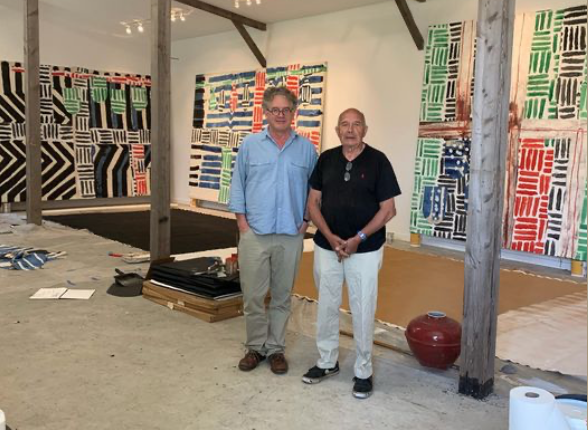
A painter of consciousness, of consciousness in the world, as it goes by
by Jonathan Watkins, curator, writer and former director of Ikon Gallery, Birmingham
written in 2023.
In the middle of the Midlands, Birmingham is the English city furthest from the sea, too far and yet not far enough away from London. Born in the first year of the second world war, John Walker grew up there during a time of unprecedented social upheaval. The son of working class parents, he witnessed the final fling of the manufacturing industries that had expanded Birmingham rapidly in the nineteenth century
Walker graduated from a local art college into a society that was caught between the promise of a brave new world – “forged in the white heat of technology” – and the legacy of an international trauma: modern shopping centres and motorways on one hand, gaping bomb sites on the other. David Prentice, a contemporary, describes how Birmingham was for artists in those days: “We agreed that [it] was appalling, not facing up at all to current issues in the art world and so on. It is very difficult to describe really how deprived Birmingham was in those days. It was a glum little city. We loved it as students because it had secret pockets of things you could find out … but it took bloody ages!”[1]
John Walker’s star rose quickly. Appreciated by teachers and peers for his exceptional talent, he was very driven but not always on the right side of the local arts establishment. This led to a split between him and the college, where he had started teaching, and a move to Blackwell, a village outside Birmingham. The story he then tells is like a leaf taken from Vasari’s Lives of the Artists:
… one day this woman came up the stairs. She said she was visiting someone in the village, and was told that an artist lived here, and would I mind if she had a look around? I was painting these big paintings, at least 20-feet wide. There were thirty of forty paintings that size, and we went through them. She sat down, I gave her some tea, and she said, “Have you ever thought of showing in New York?” And I said, “No, of course not.” She said, “Would you like to? We could show them in my gallery.” It was Betty Parsons. We became very good friends. So I had a show with her in 1967.[2]
Then followed a Harkness Fellowship, enabling Walker to spend more time in New York, and in 1972, while living in London, he was chosen to represent Britain at the Venice Biennale. An extraordinary achievement. In the same year he accepted an invitation to be the solo artist for Ikon Gallery’s inaugural exhibition at its new premises in the Birmingham Shopping Centre – poignantly located between a Habitat store, promoting a cool modern lifestyle, and an army recruitment office. A coup for Ikon, the show comprised chalk drawings made directly onto the gallery walls, a rare (and brave) diversion from painting on canvas that gives it legendary status in local art history. According to Ikon’s then director, Simon Chapman, it was “astonishing”.[3]
* * *
Forty-five years later, I was the director of Ikon when I met John Walker for the first time. I saw the catalogue for his most recent New York exhibition and was similarly impressed by images of the new paintings. His eightieth birthday was imminent and it quickly dawned on me that another solo show at Ikon was long overdue, this time to celebrate the achievement of an artist, Birmingham born and raised, who was continuing to go from strength to strength. I wrote to him asking if he was interested, he said yes and we arranged a studio visit.
And so to Maine. New England. With old England long since behind him, John had spent intervening years in Australia before returning to the US, teaching in Boston while setting up a family home and studios in and around New Bristol, looking out onto the Atlantic. Where he now lives and works is a far cry from where he grew up.
On arrival one is immediately struck by the elemental nature of the place, the sea, the big sky and a landscape that is at once tough and picturesque. More weather than English drizzle. John is a good guide, driving along coast roads in his pickup, stopping off at favourite cafes and diners on the way to locations of particular interest, some of which have inspired him to paint. One such he has renamed “Shitty Cove”. He explains, “I can’t paint the scenic part. I’m anti-scenic. It took me about ten years before I could paint the place, even though I was living there. I found a place where it smells, and all the garbage comes in and that allowed me to paint because it wasn’t scenic.”[4]
During studio visits we concentrated on paintings that might be included in the Ikon exhibition. Characteristically they flirt with the line drawn between abstraction and figuration, but with a formal clarity and colour that is quite unlike an earlier deliberate muddiness. John’s use of striation to suggest waves and tides is visually compelling – in a Aboriginal kind of way – and the occasional repetition of stylised fish motifs fits in with an aesthetic strategy that has served him well throughout his artistic career, but now it is smartly “dumb”, less arcane, more obviously about a here and now. This is work that has an edgy beauty that is as refreshing as it is confronting. It keeps us on our toes.
This was the key to the success of John’s exhibition at Ikon, the reason why it not only attracted visitors of his generation, but also appealed to younger artists, especially those who, like him, prioritise the formal inventiveness that paint affords. When he says, “It is the height of ambition, it seems to me, to be a painter”, it is not about the fetishisation of the medium, or art for art’s sake, but rather an aspiration to the condition of free-verse poetry.
This last thought occurred to me and then I remembered that John was a good friend of William Corbett, a poet at the heart of literary life in Boston. In the catalogue for our Ikon exhibition, we published a poem by him, dedicated to John, and the transcript of a lecture he gave on John’s work at the New York Studio School shortly before Corbett’s death in 2018. The lecture is especially touching, referring to time the two men spent together while teaching at Boston University: “I loved working with him, saying what I, a poet who loved painting, could get away with saying. Loved the gossipy hours over wine after crits with the painters. Talking for five or six hours unwinding … More laughter than yackety yack.”[5] The admiration was mutual, and each clearly identified with the other. In an interview some years previously, Corbett described himself as “a poet of consciousness, of consciousness in the world, as it goes by.”[6] The same could be said for John Walker, painter.
Such sensibility and unpretentiousness are rare in the art world. Gossipy hours over wine after long days of installation, unwinding, more laughter than yacketty yack, it was a privilege having him back in Birmingham.
[1] David Prentice, interview in Some of the Best Things in Life Happen Accidentally, exhibition catalogue, Ikon Gallery, Birmingham 2004, p.117
[2] Jennifer Samet, ‘Beer with a Painter: John Walker’, Hyperallergic, 18 May 2013
[3] Simon Chapman, ‘Welcome to Ikon’, This could happen to you, exhibition catalogue, Ikon Gallery, Birmingham 2010, p.132
[4] Jennifer Samet, Op, cit.
[5] William Corbett, ‘John Walker Drawing’, John Walker. New Paintings, exhibition catalogue, Ikon Gallery, Birmingham 2019, p.14
[6] ‘The Romance of Life and Art: An Interview with William Corbett’, Rain Taxi Review of Books, Spring 2005
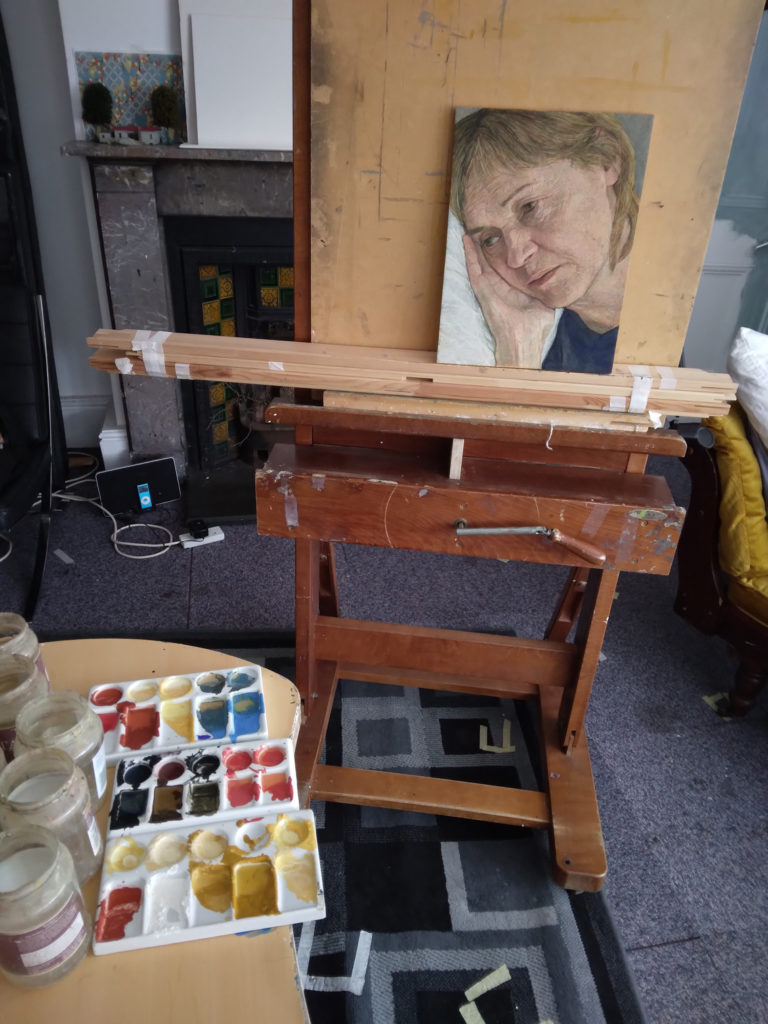
In conversation with Dr Claudia Milburn, May 2022
CM: What is your background / training and how influential has that been?
AW: I did a diploma in Foundation Studies at Farnham College of Art in 1984 after my A-Levels (I did A-Level Art). You tried everything on the Foundation course – printmaking, sculpture, photography and life-drawing. I hadn’t really done any life-drawing before so that was very new to me and quite influential in a way. I didn’t really learn a lot about techniques or the practical aspects of painting at Farnham but it was more to do with analysing a subject and ways of seeing. That was more important, especially with one of the tutors there – Karn Holly, her whole practice was focused on drawing. I think she was quite influential, maybe not so much at the time but the ideas fed through later on, particularly when I re-engaged with life-drawing after leaving Farnham. She was the most influential tutor I had at Farnham, or anywhere really.
CM: How about your peer group at Farnham – were other students influential?
AW: Well, in the sense that they introduced me to other ways of working. At that point I had only done my A-Levels in a small group, and this was then a larger group with so much more going on – different approaches to painting, drawing etc.
CM: Were you clear at that point that you wanted to become a painter?
AW: I think I had decided that painting was my priority although they tried to push me more into printmaking initially. I didn’t have the confidence or the ability then to say that I wanted to become a painter with a particular vision, so it was more of a hard slog. I quite enjoyed the disciplines of printmaking and sculpture, but it was painting really that took my focus. I was there for a year then I went to Portsmouth Polytechnic to do a Fine Arts degree. It was a three- year course but I only stayed for a year. After the first year I decided to take a year out which became almost permanent. I don’t know why really, I just decided I wanted a break from full-time education and was intending to go back. I didn’t go back to Portsmouth, maybe the course just wasn’t working for me, I’m not really sure why, it’s hard to reflect back to know.
CM: And did you have formal art education training after that?
AW: Well, then I started working for a picture restorer quite near to where I am in Walton-on-Thames. It was purely accidental; I was working in the restaurant next door washing-up for a few days a week or an evening a week. The picture restorers were next door and I used to pop in for art materials and I just got chatting to the restorer and he offered me work for a few days per week. That was for a few years and it was very useful because I learnt more about painting there, I learnt about cleaning paintings and about restoring frames. He was also a painter and very skilled in different techniques – oil, watercolour etc so I learnt a lot from him.
CM: Were you painting while working for the picture restorers?
Yes, I never really stopped painting after Portsmouth. I started going to life-drawing classes and then continued working on my own.
CM: Was your work very different at the time?
AW: Yes it was although there was the figurative aspect to it. I was looking at the time at David Bomberg and Frank Auerbach and, for a period, I was working very much like them. I would go to Guildford to the top of the multi-storey carpark and draw the city looking down. The work was reminiscent of the charcoal drawings of Bomberg’s drawings of Jerusalem and Ronda for example. And then I would try and paint like that too, portraits and landscapes in that style. Then later on I got interested in Freud having gone to see his exhibition at the Whitechapel in the mid-eighties. Suddenly he became much more influential. I moved more towards that way of working and less in the expressionistic approach to paint. It was especially earlier Freud that I was interested in at that point which kind of tied in to working with tempera. The first thing I did successfully with tempera was a self-portrait which was very much influenced by Freud and his approach. This was around 1990/1991. Before that I did go back to an art college – in Cambridge – to do an illustration course. I felt I needed to do something that was going to be more vocational and potentially find work as an illustrator, but that didn’t really work out. It was interesting doing the course, but not what I really wanted to do. My interests lay elsewhere, and it helped to cement that really. I didn’t finish the course even though they had put me straight into the second year. I didn’t actually qualify though it was all useful despite not getting the qualification.
CM: And, after that, what was next?
AW: I came back and started working for the picture restorer again and carried on my own studies and research. At that time I was working in the Bomberg style and experimenting with tempera as well. I then starting to work in a more realistic style, influenced more by Freud possibly. It took me a long time to produce a successful painting in tempera. I didn’t have anyone to teach me, so I had to get it all from books. The picture restorer was using it but not in the same way, so I had to do my own research to work out how to use it in the way that I am now – from scratch, mixing up the pigments, working on Gesso panels etc. It was quite hard to find all the information out, it would be easier today with YouTube and the internet, but this was pre all that so much more a case of trial and error.
CM: Was it the tempera medium that caused the shift in your work?
AW: Yes, I think it was the medium and it’s also drawing, it linked to drawing. I started going to a lot of life drawing classes, portrait drawing classes, around that time, as well and working with tempera. I was really interested in drawing which tempera complemented. It’s quite limiting in some ways whereas oil can be manipulated and moved around in so many ways. There are many techniques associated with oils so I felt the tempera made it easier in a way because it was more limited in its scope of application which suited me.
CM: You have worked almost exclusively with the medium of tempera for many years. The process it requires is painstakingly slow, requiring patience and dedication. Why do you feel this medium suit your way of working more than any other?
AW: Well sometimes it is frustrating to work so slowly. I do still occasionally work in oil which is kind of liberating in a way, but I feel that I’m a better tempera painter than an oil painter – it feels more personal to me. I had more of a personal way of using it, so it wasn’t so influenced by other people.
CM: Is the fact that there are not so many painters working with tempera part of the sense of privilege and identity in working with the medium?
AW: There’s an element of that now but I wasn’t really aware of that when I started using it, I didn’t use it for that reason. I found it by accident really, and then I liked some of the results I could get with it, and the physical quality of the medium. I always found the oiliness of oil paint difficult, particularly early on when I was using it and I tried glazing etc. The tempera was much easier, although it is slow as a process, it enabled me to achieve results.
CM: Your technique with using the tempera is not dissimilar to pointillism. Do you feel an affinity with the post-impressionist genre?
AW: Yes, there is a pointillist element to it when I use it though you can use it in different ways. Initially I was just working on portraiture, and occasionally still-life. You can’t blend it, you can’t push it around once it goes on to the panel, it dries almost immediately. It’s quite hard to modify what you have done before so you have to just add other touches of paint to modify what’s gone on underneath and you build up a layering of paint. Although you could use it a broader I way, I found small touches, cool colours against warm colours, worked for painting skin, and for portraiture in general. It helped to create all the little nuances that you find in skin which is not just one colour or one tone. it helped me to do that, you get optical mixing almost, you get a red against green for example, and little touches of each colour. I wasn’t setting out to be a pointillist although I do like pointillism. When I paint I don’t do a lot of colour mixing on the palette, I try to do it with the combinations of pure colour sitting side by side on the panel. I do feel an affinity with the post-impressionist painters – if I’d been around then I’d have liked to have been one of them. I like Seurat’s work particularly. His work has a monumentality about it. So yes, there is an affinity there, but I was very interested in realism so although it’s the pointillist technique, it’s more to do with realism, a realist way of working.
CM: You frequently work on a small scale. Is this simply due to the delicate, slow process of tempera painting or is scale itself a significant element of your work?
AW: Well I have worked on larger scale pieces, some of the figurative pieces I have made are up to 4 or 5ft. It really works well once you go over 50 or 60 inches, they just take quite a long time to do. I quite like going from one to another. It works at both scales, it works on a monumental scale and can work equally well at something that is only a few inches across. It’s good to have a larger piece on the go in the studio and much smaller pieces too so there’s a shift. I don’t think it would be as satisfying to always be working at the same scale.
CM: Your figure compositions appear to have a strong narrative content. What factors determine the pose or composition for your sitters?
AW: I’m not trying to create a specific narrative, there’s something going on there but I’m not really sure what it is. Usually it is just using some of the props and objects that are in the studio. If someone comes to sit for me it suddenly generates ideas – the way they relate to those objects can create something. The sitters have no real relationship to those objects, they are not familiar to them, so there are implications of a narrative but it could just be viewed as a straightforward objective painting, objects in the studio or a still life for example. I quite like the idea of there being another aspect to it as well, it’s something I’m more interested in as I go forward I think.
CM: So, it’s more about creating a layer of intrigue?
AW: Yes, it’s something else. Originally I was working purely from observation and it was all about the observation and getting it into the work, to record the truth of whatever is in front of you, but I’m starting to move away from that now. In recent years I’ve been much more interested in creating narrative elements in the work and in making that stronger.
CM: Your paintings convey a mood of quietude and stillness which gives them a particular intensity. Is this sense of arresting time an aspect that you are consciously trying to achieve with portraiture?
AW: I am interested in that, if I can achieve it. I’m not sure how you actually achieve it, but I am aware of it when I look at painting of this sense of stillness which is always intriguing. It is something that interests me. I think the tempera can lend itself to that, something about the medium and the slowness of it, created over time and with lots of repeated sittings. It is something that interests me so maybe it is just that interest feeding through in the work.
CM: This exhibition concept is really interesting in this respect with the Margaret series of paintings – individual portraits, stilled in moments in time, repeated over a period of time – viewed alongside your more recent portraits. There’s a sense of layering of stilled time – do you agree?
AW: Yes, certainly. I had the first sitting with Margaret soon after I moved into her house where I had my studio. She was sitting for me almost immediately when she was 80, and the last sitting was in 2016 when she was 96 and she sat almost every year, on and off, so that was a long period of time.
CM: Approximately how long do your painting sessions with sitters tend to take? How much does the work change from your original conception?
AW: They can be quite long sittings. I had a four-hour sitting this morning which is quite exhausting. And yes, things change, the lighting changes and sometimes things are different about a model, the hair changes etc. I do take photographs as well to use as reference sometimes and drawings. Once I’m painting direct it takes the painting forward, then I’m sure will change again and can do so quite drastically. I do place tape around where the models are sitting and around my easel to try to get them back into the same position but even then things change slightly. When I look back at the original drawing after I’ve finished a painting it can be really quite different, aspects can change quite dramatically.
CM: Do you converse with your models while working or is this in silence? Do you allow them to view the evolving work?
AW: It’s quite hard to have complete silence and you have to give models breaks, every half an hour or 40 minutes and we will talk then. It depends on the model really but I’m quite happy to gauge it, if they want to talk a bit, but obviously not when they are actually sitting. It’s hard to concentrate if they are moving around. I don’t make a point of showing the work to them, in that sense it’s not collaborative, I’d rather not show them. Sometimes sitters are quite engaged, I’ve had art students who have sat for me and they can be quite engaged so they’re the worst really! It’s probably better if they don’t have any interest in art at all, they’re the perfect sitters!
CM: Is it ever necessary to abandon or re-start a painting because the subject matter or composition is not working for you?
AW: Yes, or the models disappear! It’s always a worry especially if you’re working on something, for example, over a six-month period since the initial sitting anything can happen. I must have abandoned pictures going back but generally I think I see things through to the end somehow. But it is always a possibility that something is going to happen. I try to get models that are going to be reliable before I commit. I try to get to know them a bit by having a few sessions drawing them and then I find out if they’re going to turn up or what their plans are, that they’re not going abroad for two years or whatever.
CM: Do you feel your approach to portraiture has evolved over the years since you have been working with tempera? If so, how has it changed?
AW: I think it has changed but not dramatically, more incrementally. Looking back, there’s much more colour in the work now than there was initially. When I started using tempera it was more monochrome, my palette was more restricted back in the 90s. Particularly with the still-lifes now, much more colour has come in. I was afraid of using colour initially or perhaps I was overwhelmed by it but I am more confident with colour now. It’s about confidence and it takes time. I’m less worried about decorative elements coming into the painting now.
CM: Acute observational focus is central to your work. With this in mind, can you reflect and expand on the role of drawing in your practice?
AW: Yes, I usually start with a single drawing or maybe two drawings if I try something out before actually committing to the painting. I use the drawings for the underpainting so I transfer the drawing onto the panel and work from that to produce the underpainting. I use a much more limited palette initially. I tend to put on a few layers which is not the true colour and then build the paint up with the model back in the room. I’ve always done that, starting with the process of drawing first.
CM: Would you normally work with a model every day?
AW: No, it gets too expensive to have models in every day. But actually that would be too much because I need to be on my own quite a lot as well. It’s quite hard to think properly when someone else is in the studio and to be more objective and analyse the work. I spend ages looking at the work and thinking after they’ve gone, modifying the work slightly sometimes without them. I’ve got models coming in a few times a week at the moment.
CM: Since Margaret Robinson’s death, your studio has been on Platt’s Eyot, the large island on the Thames near Hampton. What is the atmosphere on the island and why does this location suit your way of working?
AW: My studio in Margaret’s house was very different, an old Georgian house in Chertsey, with a great room and I was there for 16 years which was perfect. And then obviously I lost that when she died so had to find a new studio which is a bit of a process. I went to look at a few and none of them were quite right and then I came over here by chance. I wasn’t really looking for an island studio per se so it was just accidental really, there was some space on the island that was available, I came over to see it and felt it could work. I liked having the river there and I felt there was a lot of potential subject matter looking out of the windows. It was so different to what I had before, the light was so different because you have the light coming off the river and the outlook was very different. It’s quiet here at the moment because last year we had a fire next door and a quarter of the island disappeared – it was a major fire, like something out of a war film because there were these boat sheds which were all green corrugated iron and which were next to my building and they were set alight accidentally while someone was having a bonfire. It was the bank holiday last year and they just went up, it got out of control and there were explosions as well, gas bottles exploding. It really was like something out of Apocalypse Now. Luckily my studio was not affected too much, there was a bit of damage, but it was okay.
CM: Who or what has been your greatest influence as an artist? Have any particular artists been mentors in the development of your practice?
AW: Well mainly figurative artists, Freud and Uglow have been influential. Maybe Andrew Wyeth, I hadn’t been so aware of Andrew Wyeth but I am now and obviously he works in tempera so there’s an affinity there. It was only when I went to America that I saw his work rather than in reproductions. But also early Italian painting, I’ve always liked Giovanni Bellini and Piero della Francesca. And Morandi, I wouldn’t say that he’s been a major influence but there’s a stillness about his painting although he’s very different there’s something there. And some of the surrealist painters, like de Chirico for example. Also, Spanish painters, like Francisco de Zurbarán.
CM: You had the extraordinary commission to paint the Queen in 1996. Did this commission pose any significant challenge to your normal practice?
AW: Well it was a commission but it was also a prize I won, so I wasn’t actually doing it for her whereas normally if you have a commission you are doing it for someone and they have to like the work if they are going to pay for it. In this case I had free reign, I didn’t have to satisfy her or anyone really. But yes, you are right, it was actually quite an odd experience. When I had my first sitting, I hadn’t actually met her beforehand. I just had to go and set-up and wait in Buckingham Palace which was a strange thing to do anyway. You arrive there and then you are taken to a room and then you have to wait for the Queen to arrive. Then you’ve actually got to draw her. I was quite young when I did that and I had a lot of time to think about it, I had about five months to think about what I was going to do. They were very generous at that time, I had seven sittings which were at least about an hour and a half each time, over a three or four month period, which you really don’t get now. Now you would be lucky if you got one or two. I spoke to someone who painted her a few years ago and she only had about half an hour. It’s always hard with sitters if it’s someone you don’t know very well, I’m always worried they just don’t want to be there, that they’ve got better things to do, it’s always slightly unnerving. As a model she was actually quite animated and talkative. She didn’t sit in silence, she was talking all the way through either to me or the private secretary who was in earshot. We talked about various things, there were a few things going on at that time, the Dunblane massacre and things like that, and she was talking about some of the people outside, talking about what they were wearing, the current fashions. She was very engaged with everything, she wasn’t remote or distanced at all.
CM: How did lockdown affect your practice?
AW: It was a strange period. I quite enjoyed the first lockdown, I quite like having had to stop and reconsider everything. It was strange because I couldn’t really have any portrait sittings so I could only really work on still-lifes. I couldn’t come to the studio, so I was at home a lot. I’m not sure how beneficial it’s been.
CM: What are the latest developments in your work?
AW: I’m working on this series of small portrait heads. Obviously, that’s a subject that I’ve explored many times before, but not for a few years. It’s been at least two and a half years since I’ve worked with models. I’ve got a series of models I am working with at the moment, and all but one I’ve worked with before. Alongside these I’m working on a large figurative piece but that’s quite big so will take some time to complete.
CM: Thank you Antony, it’s a pleasure to talk to you about your work.